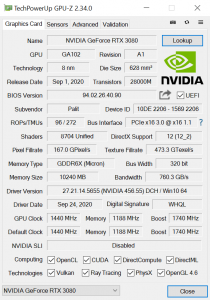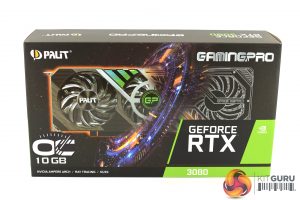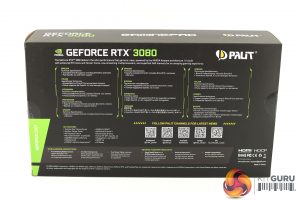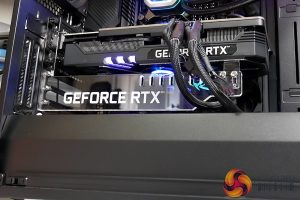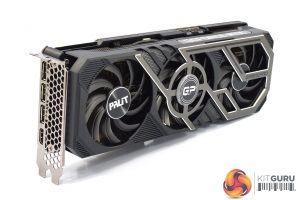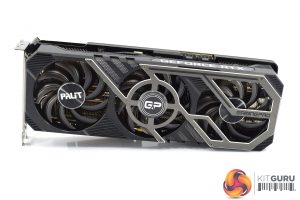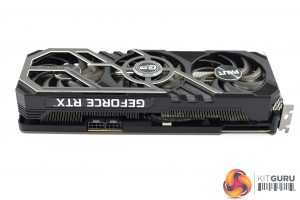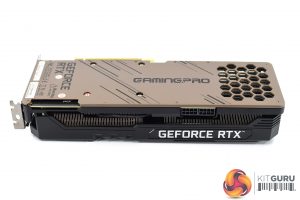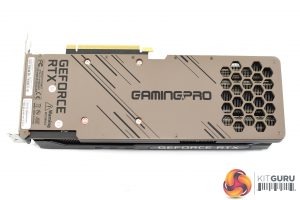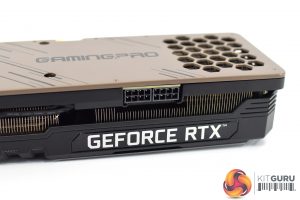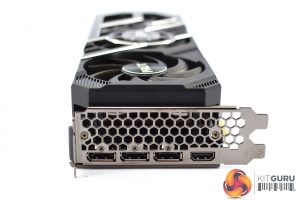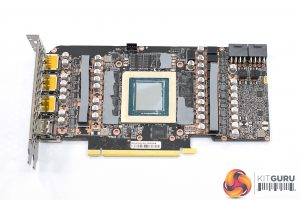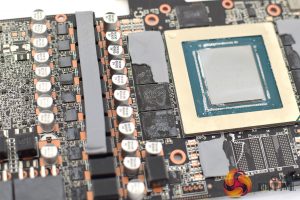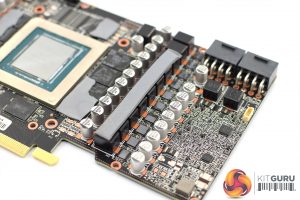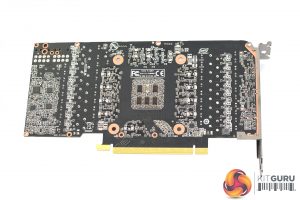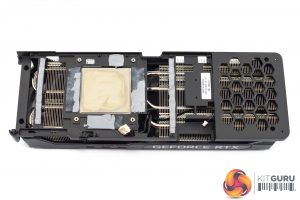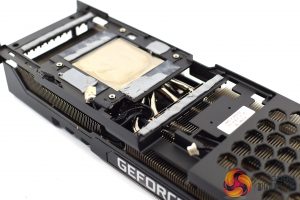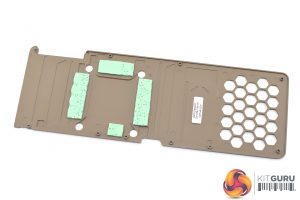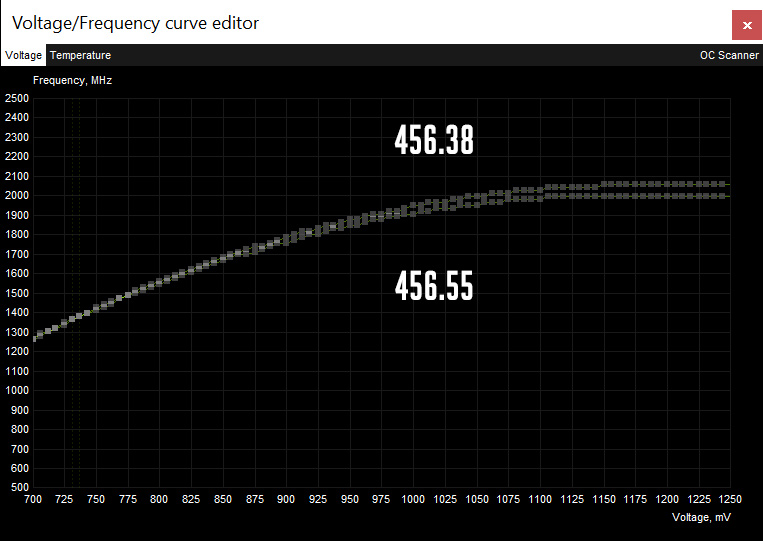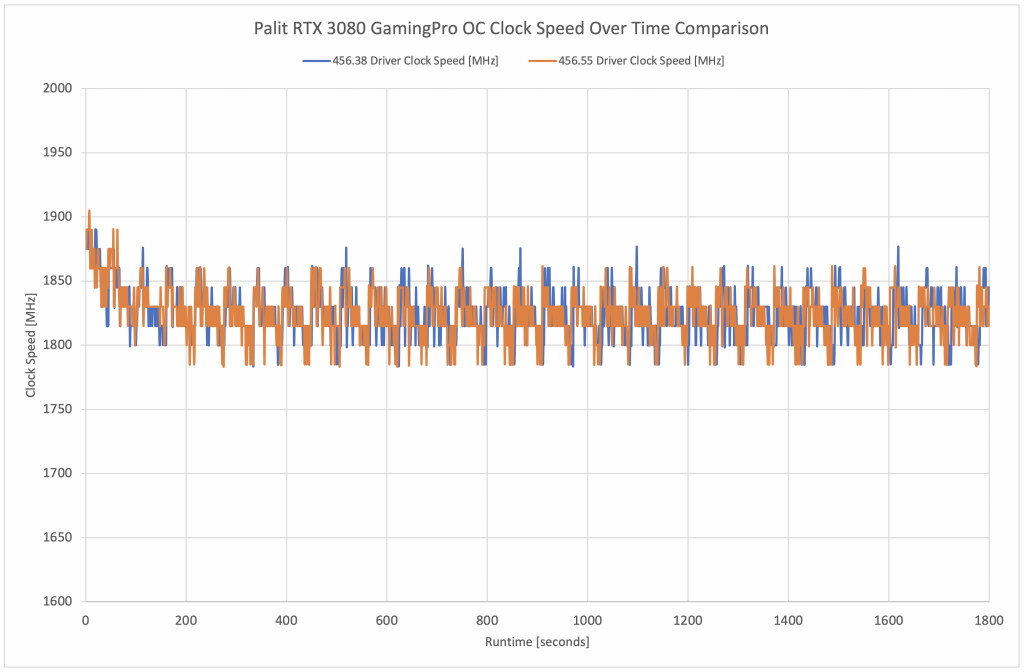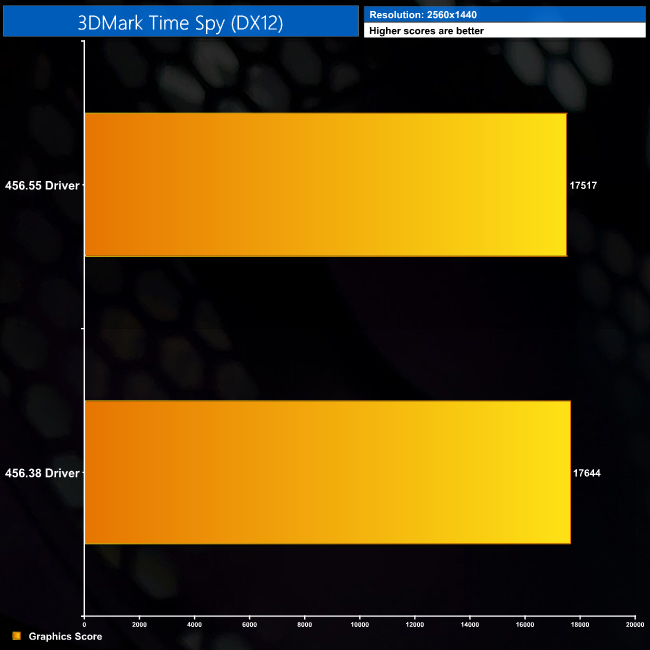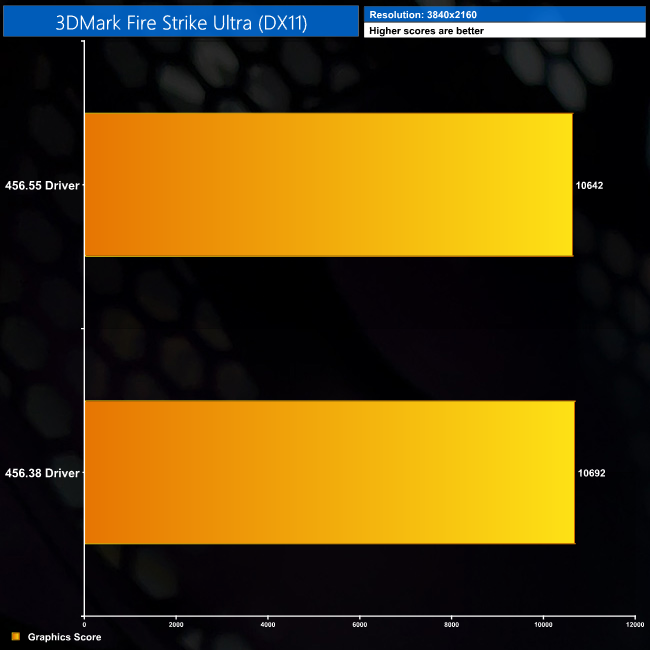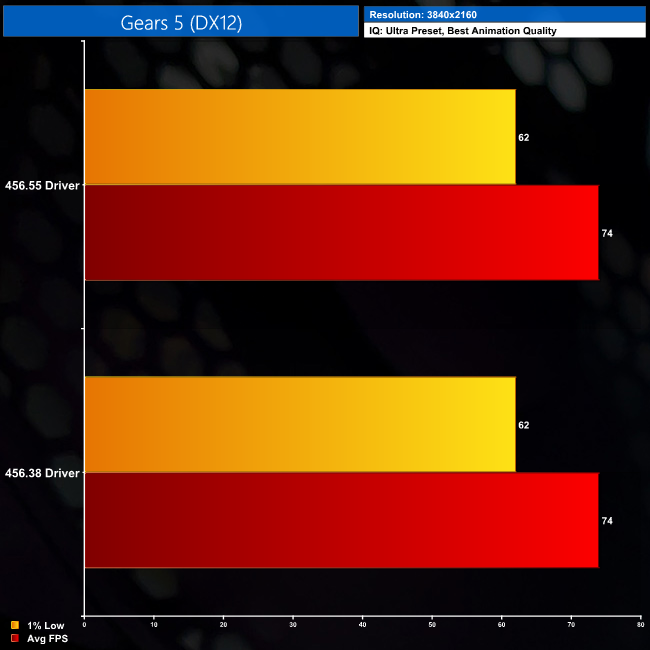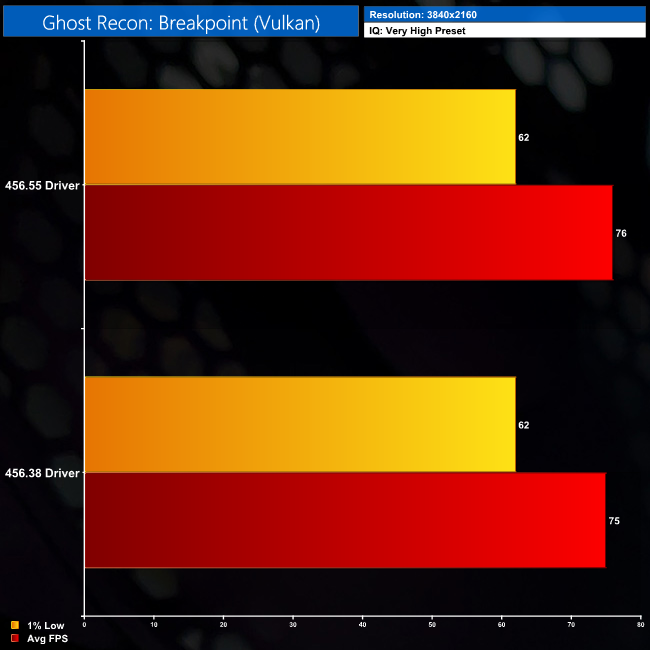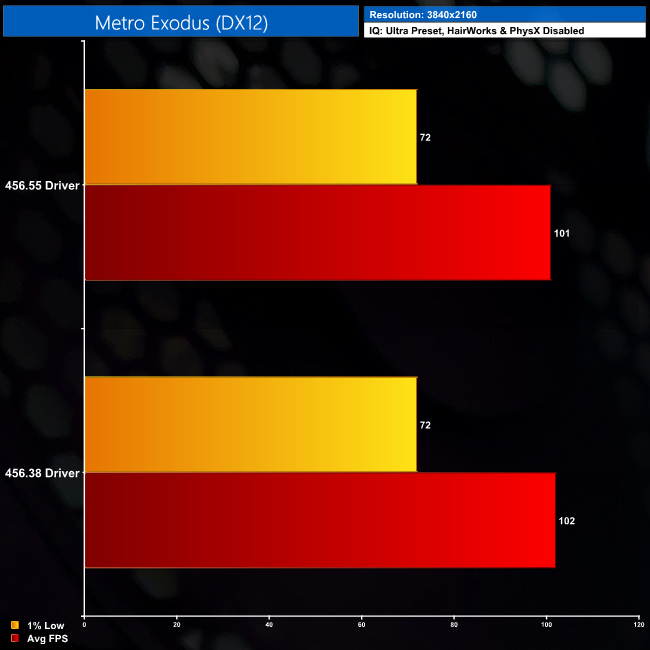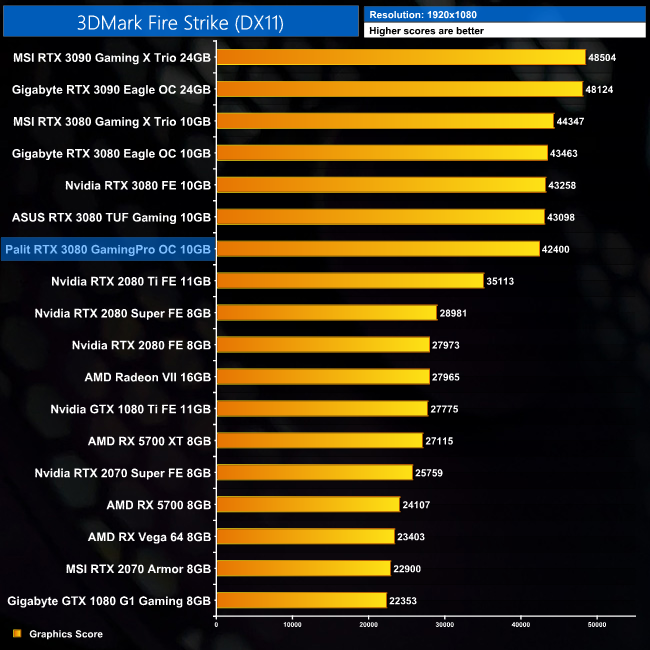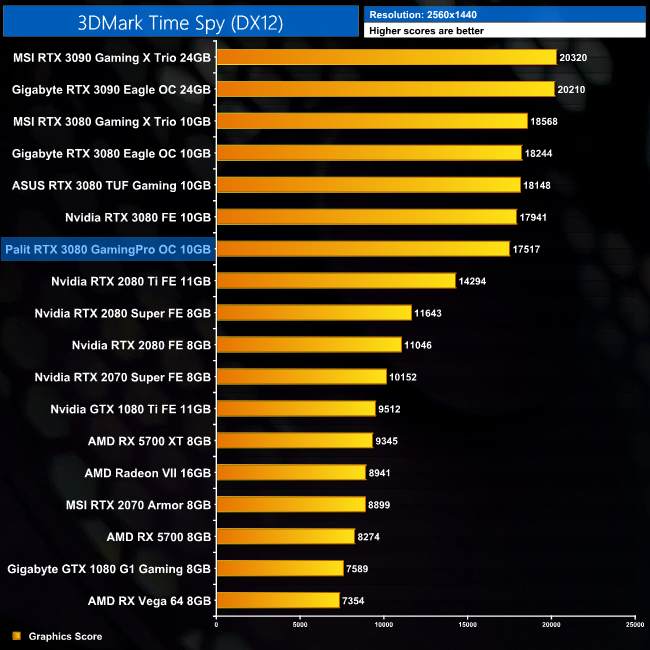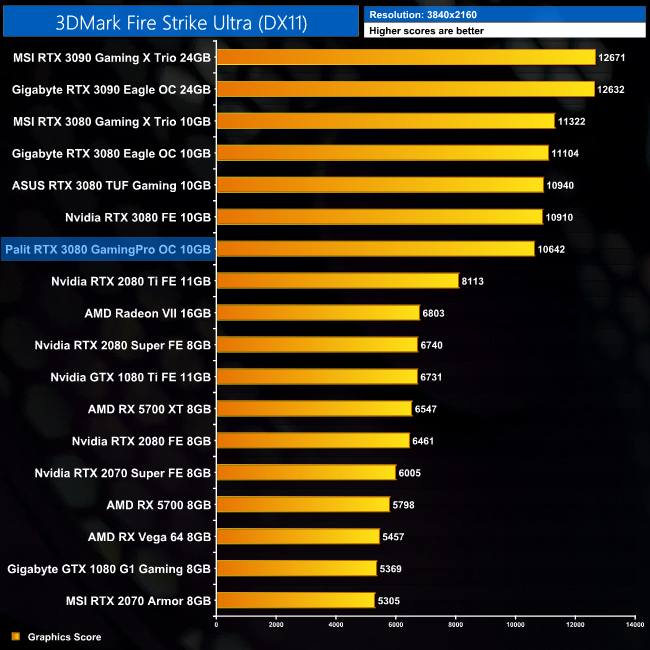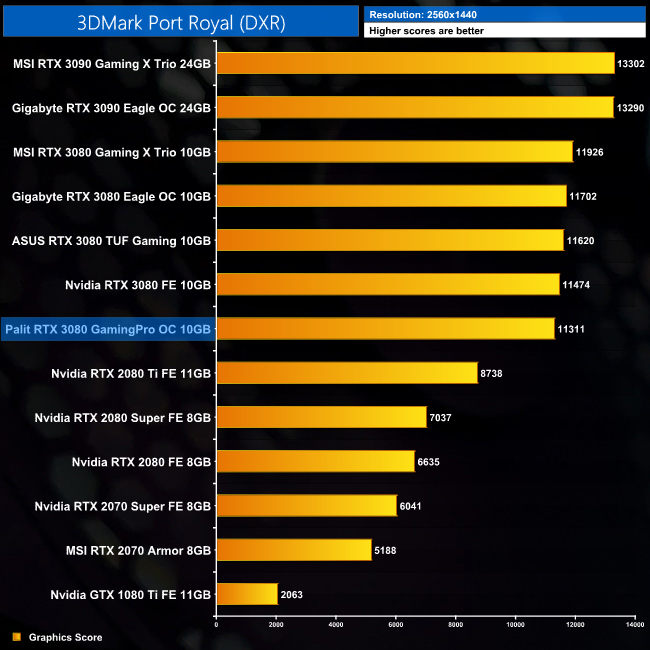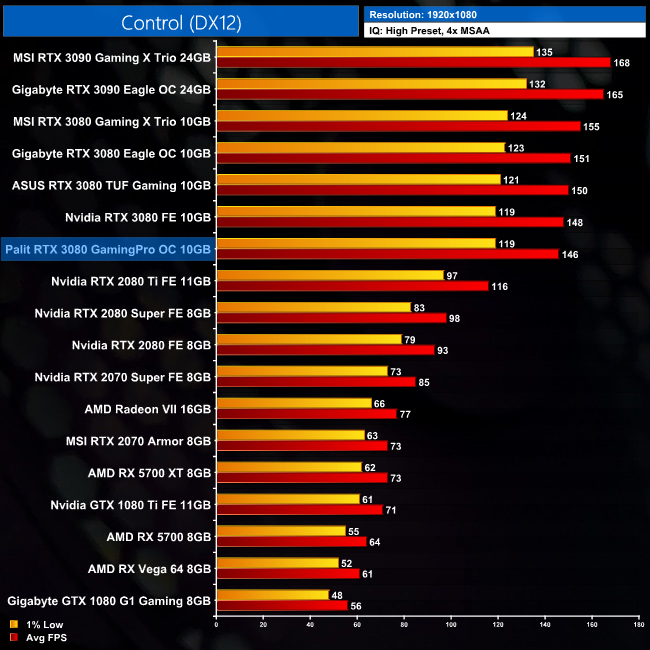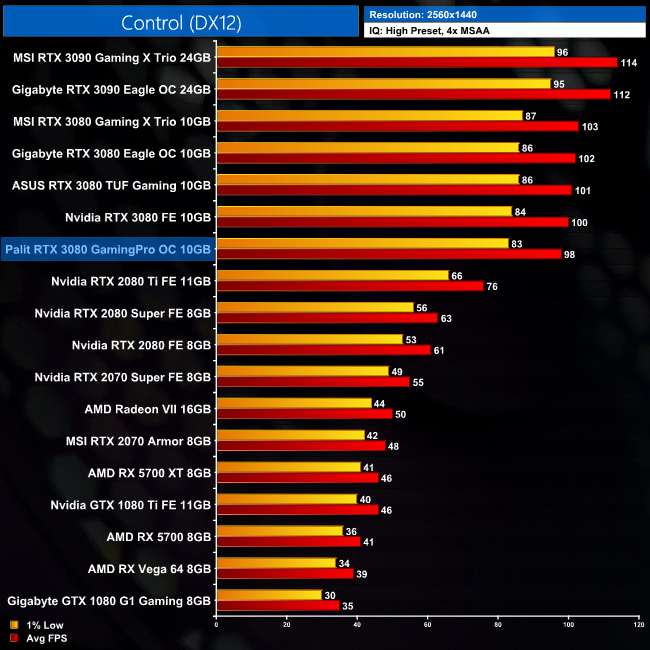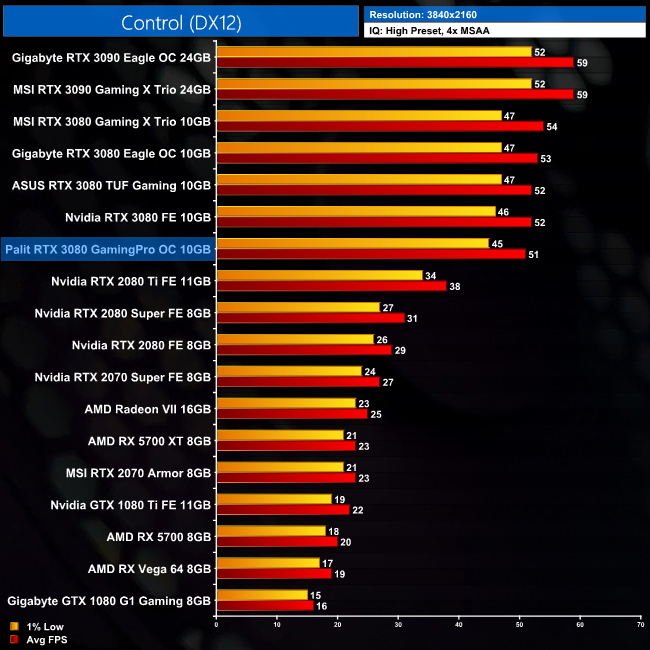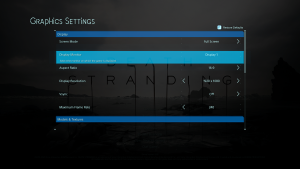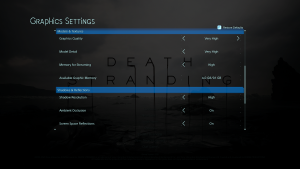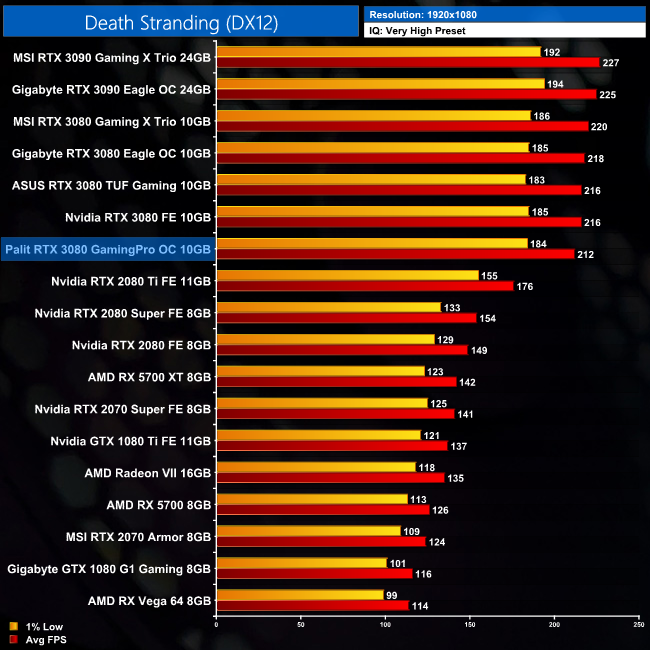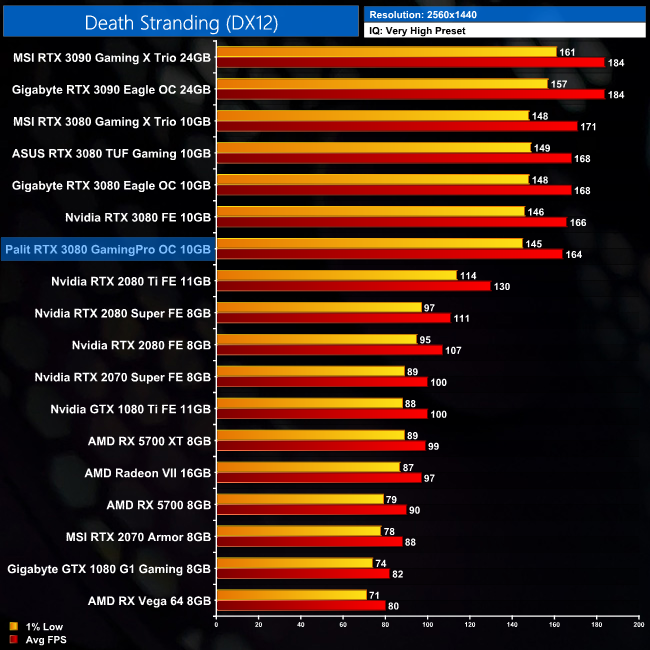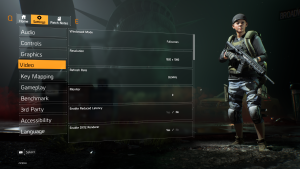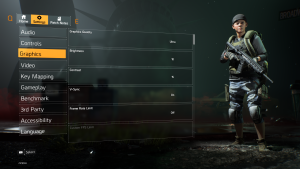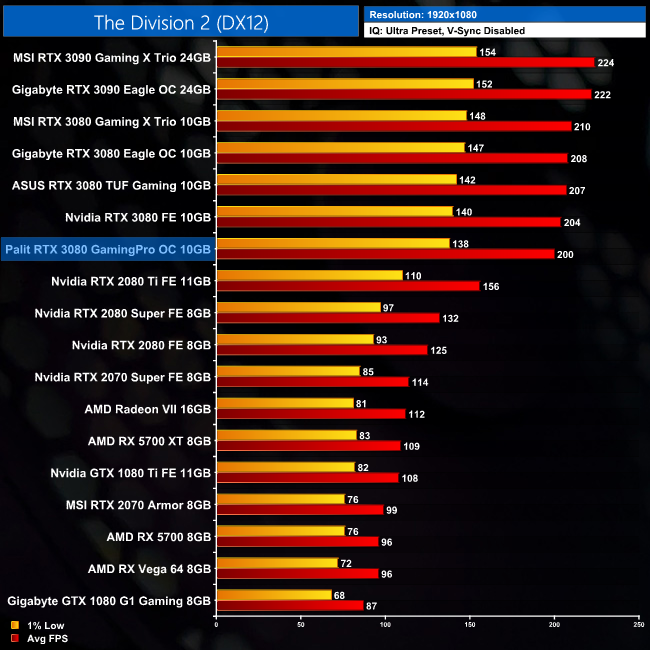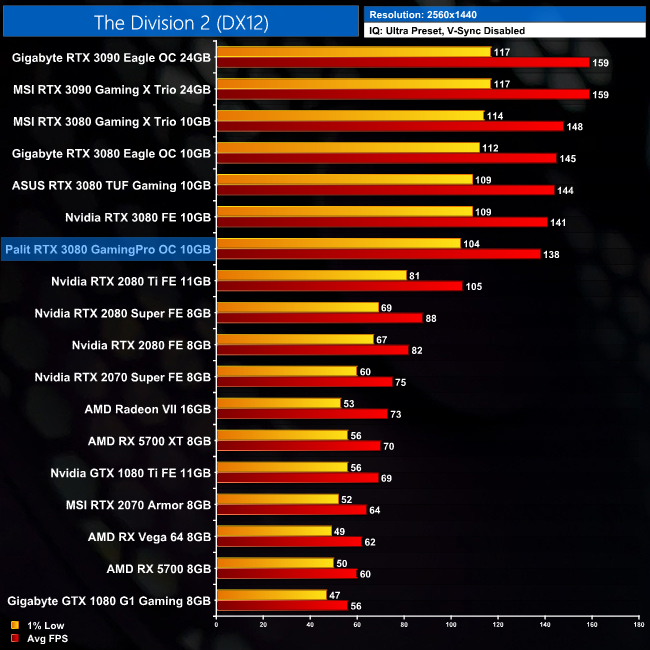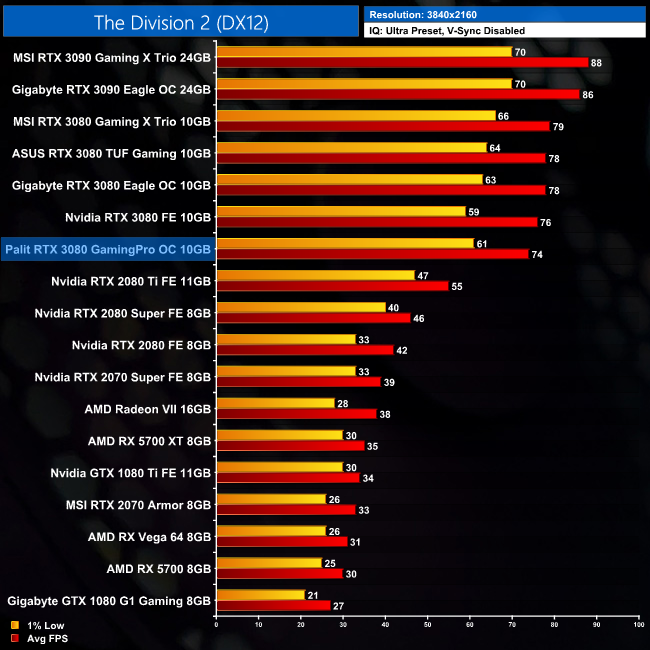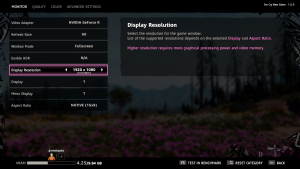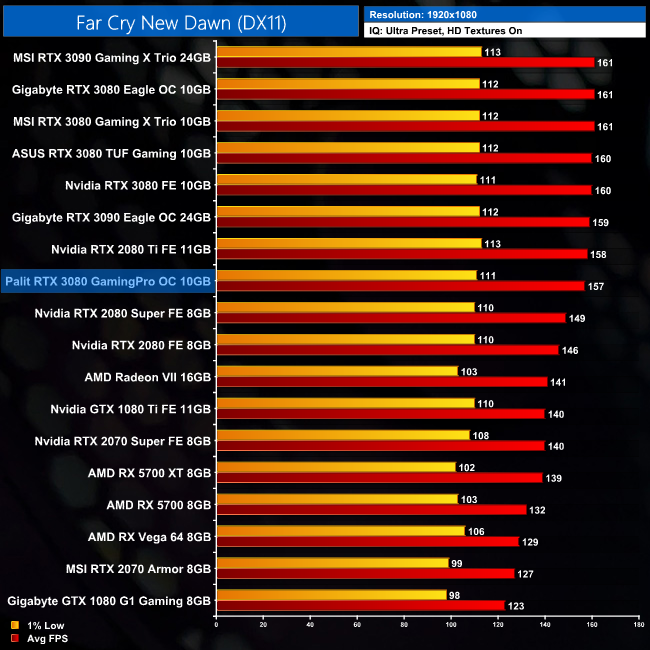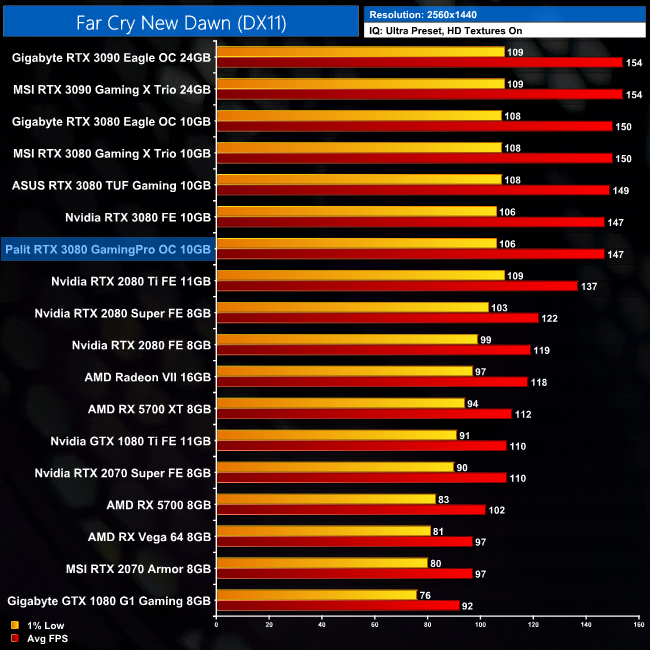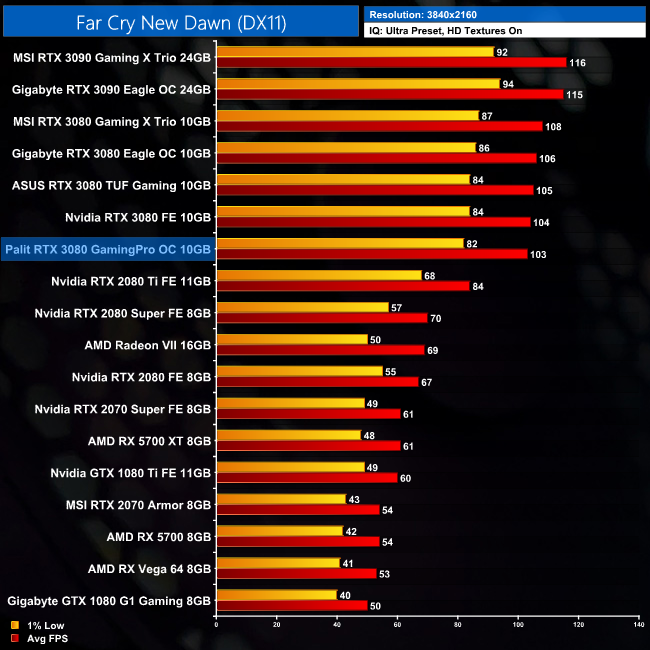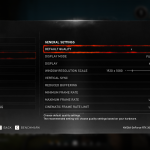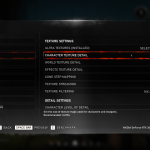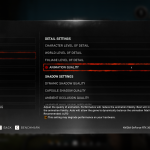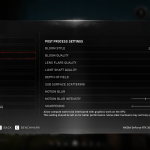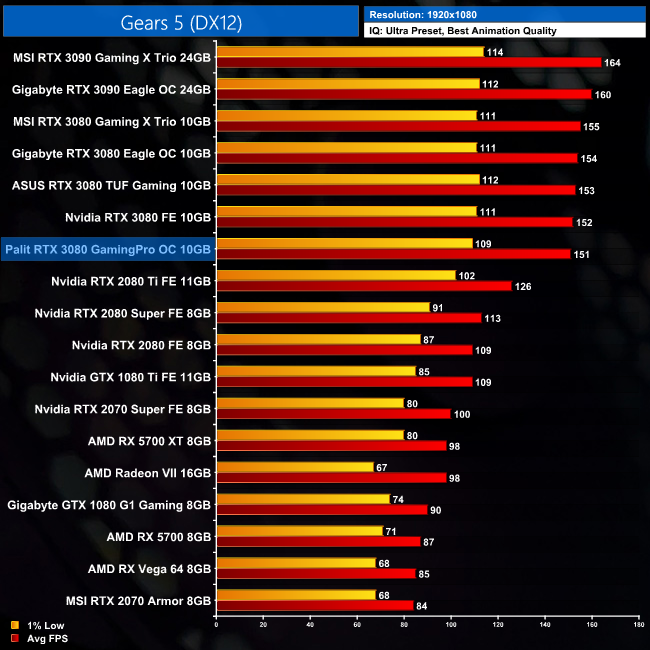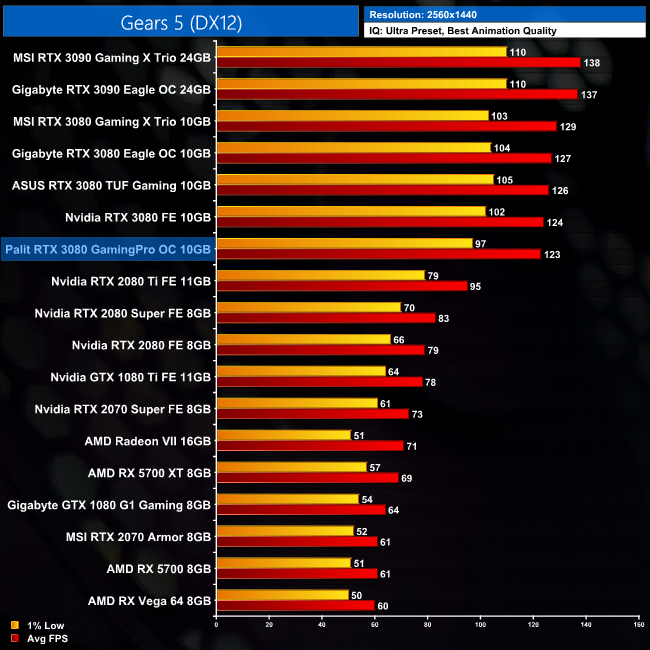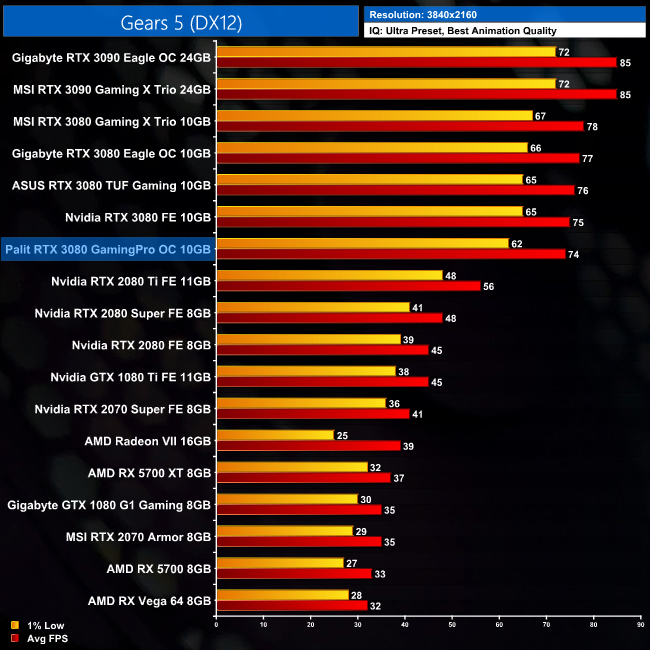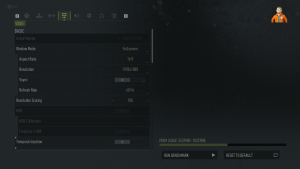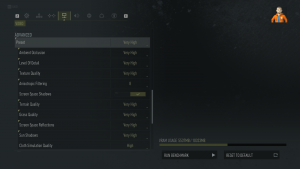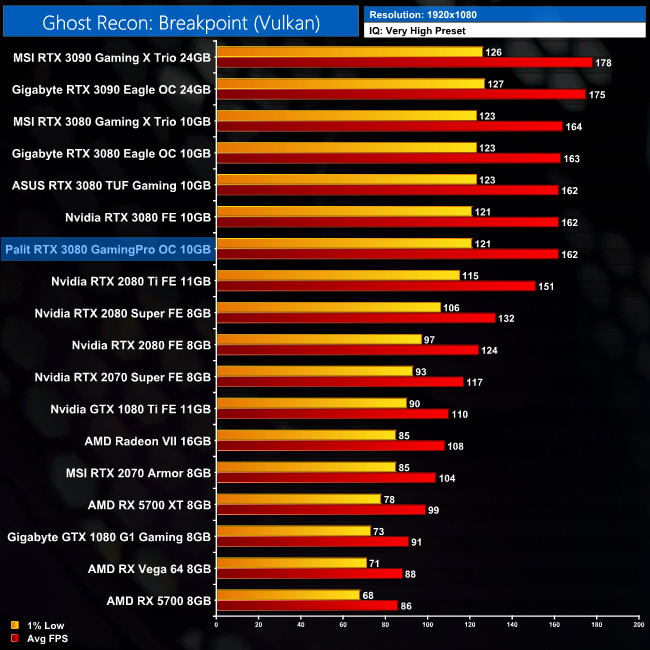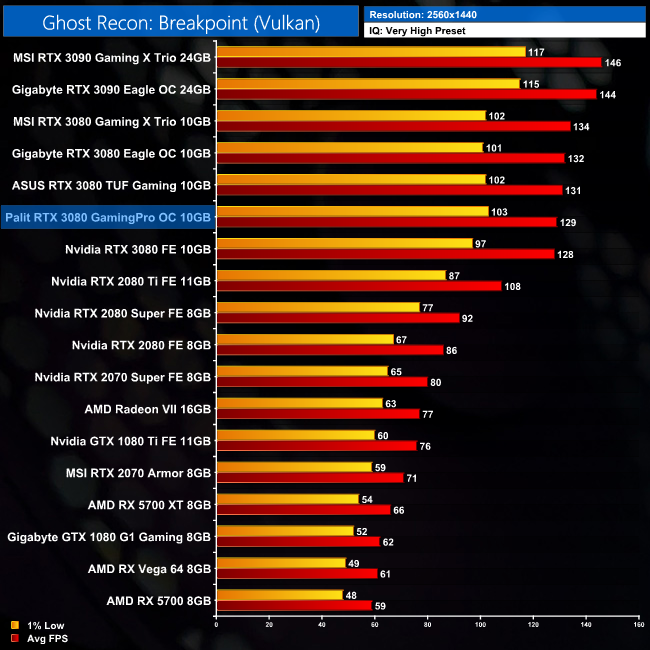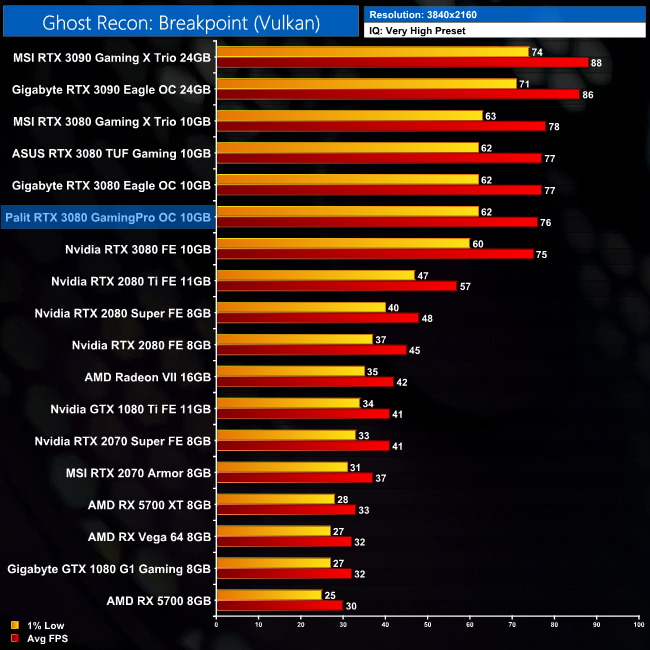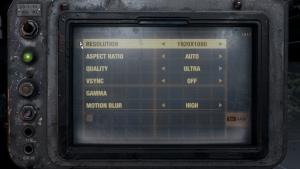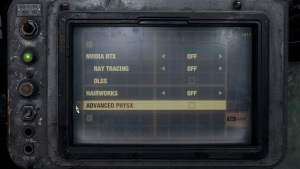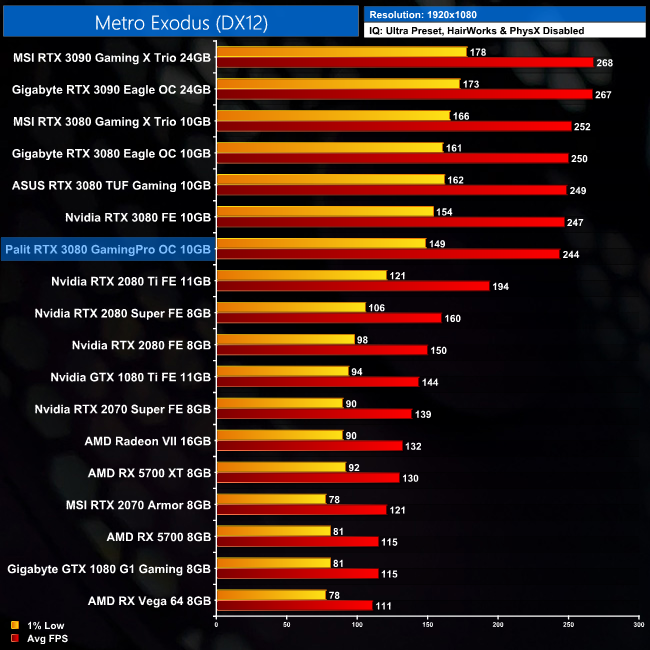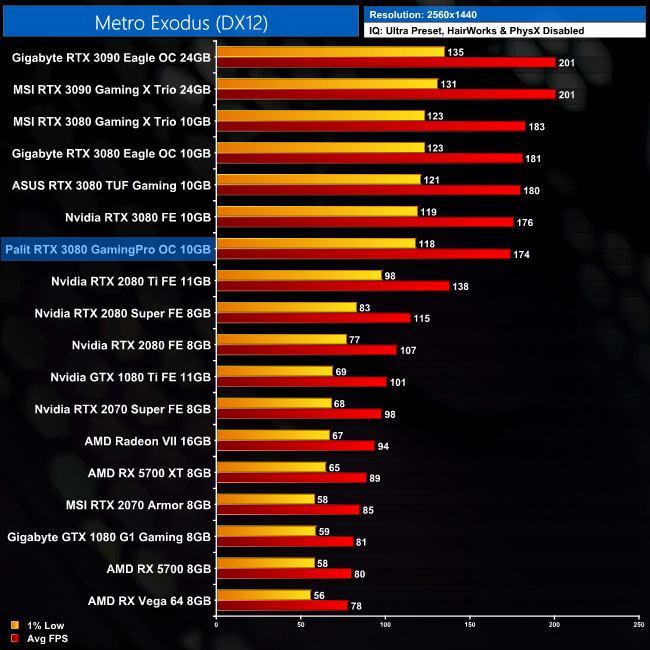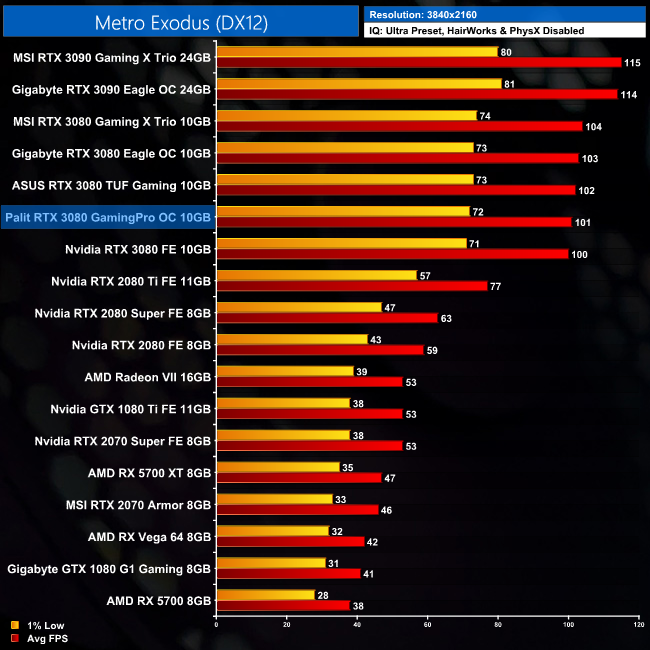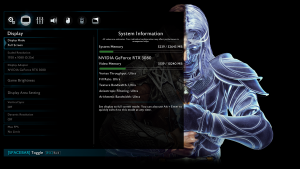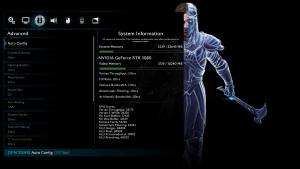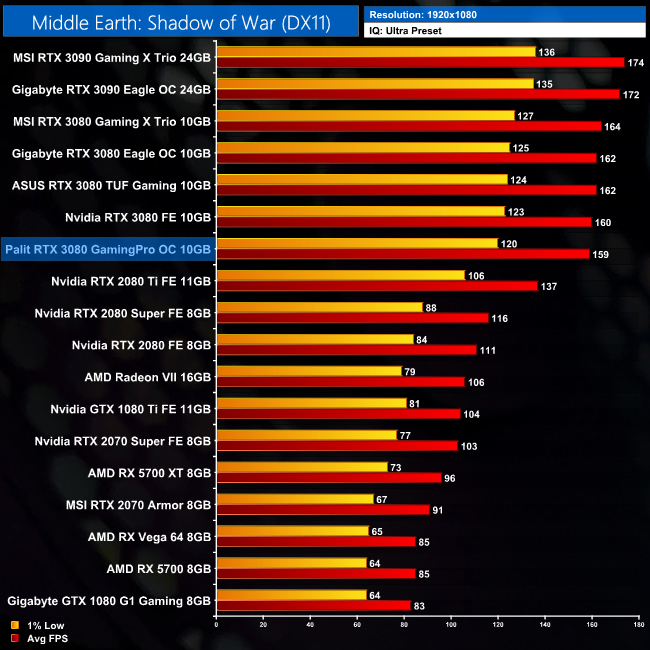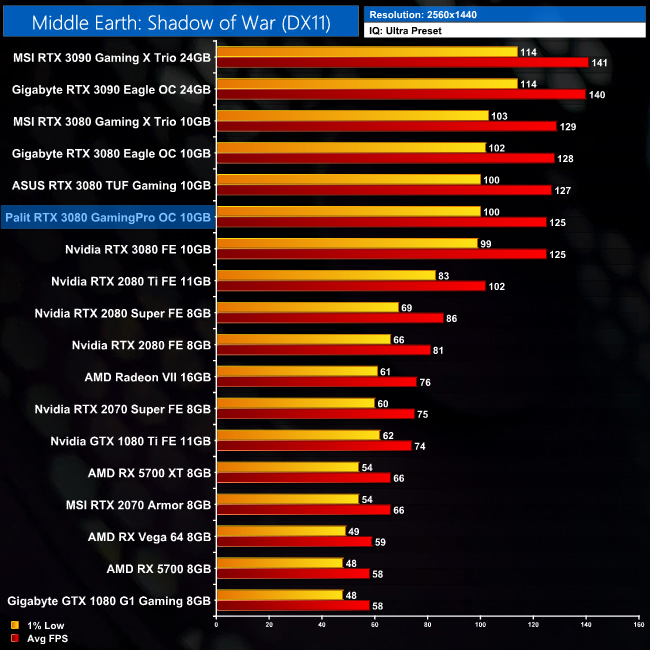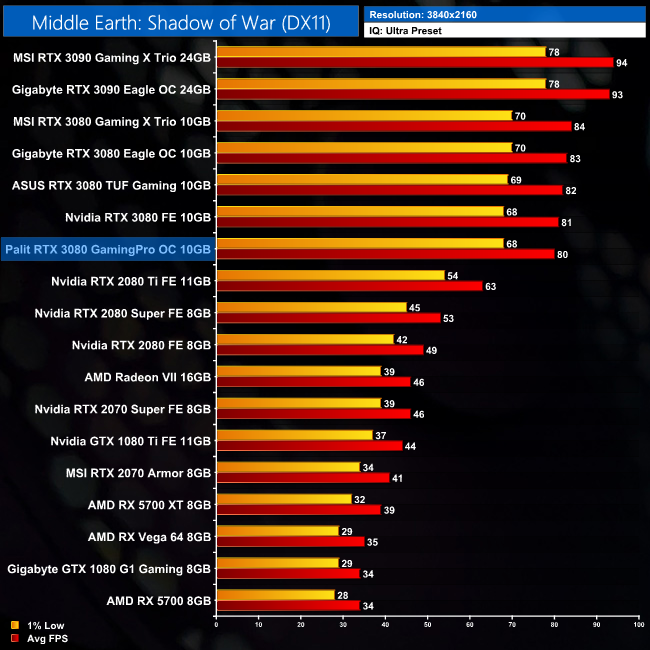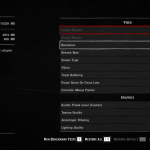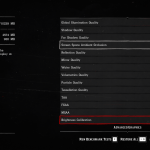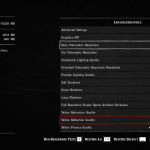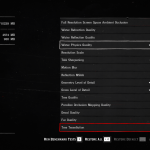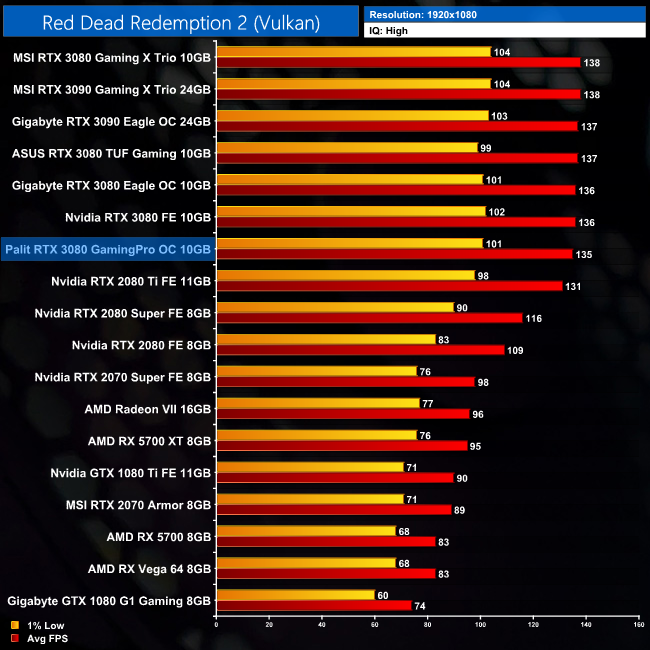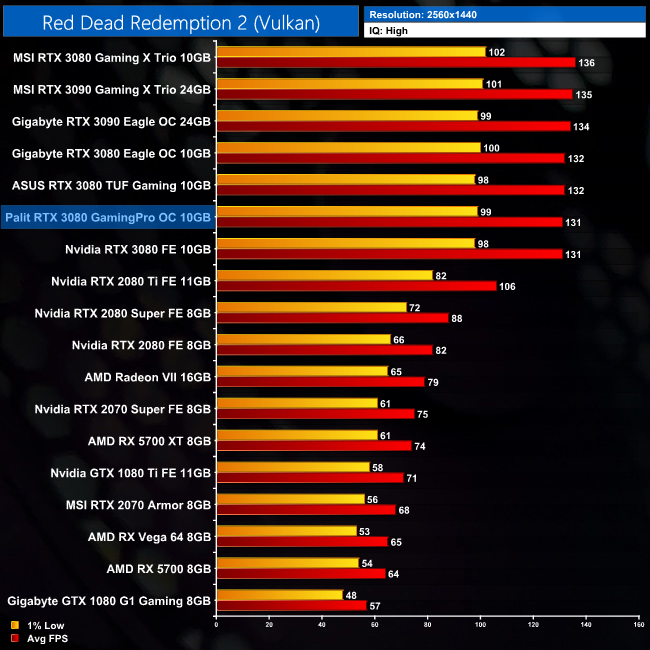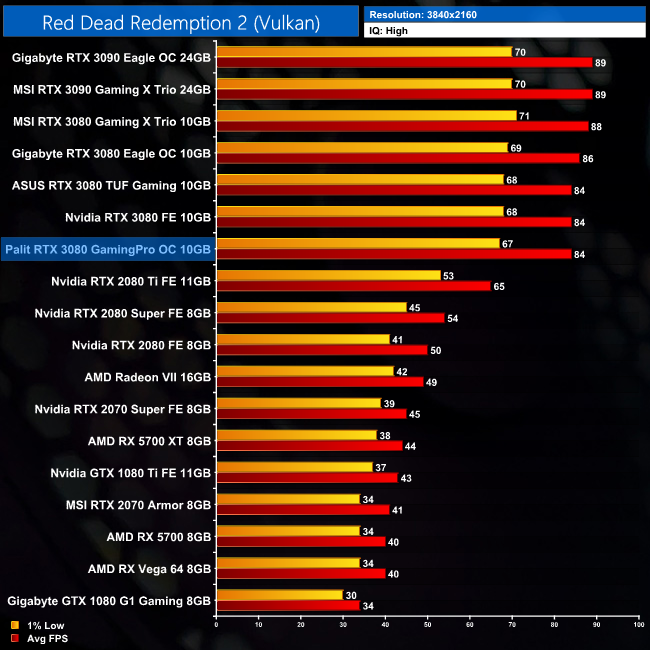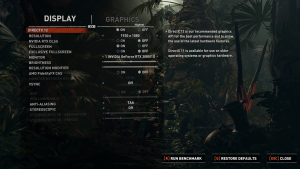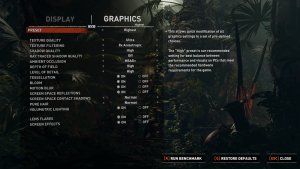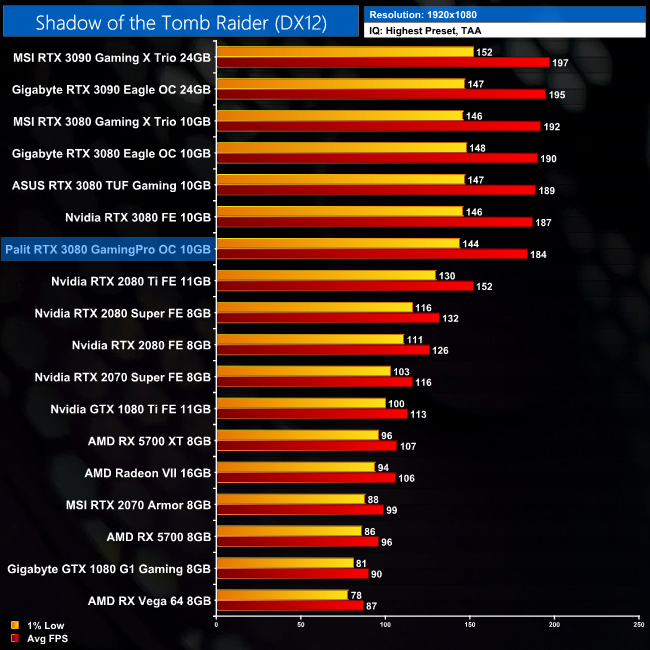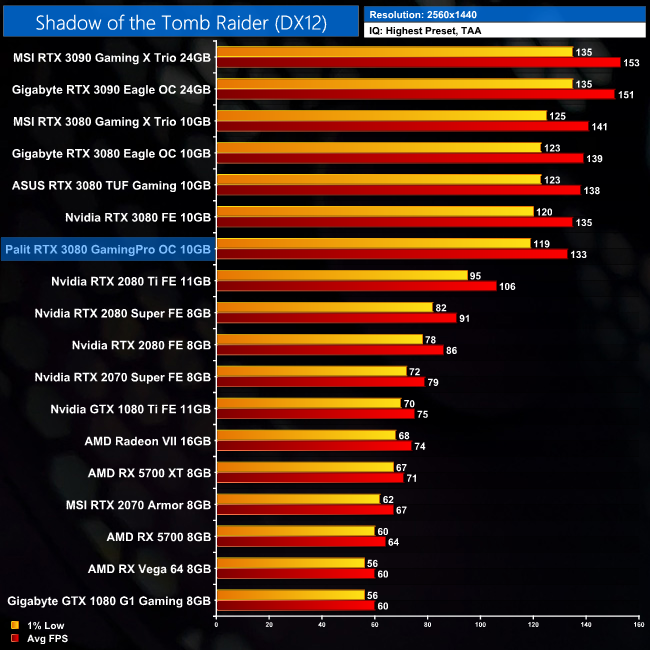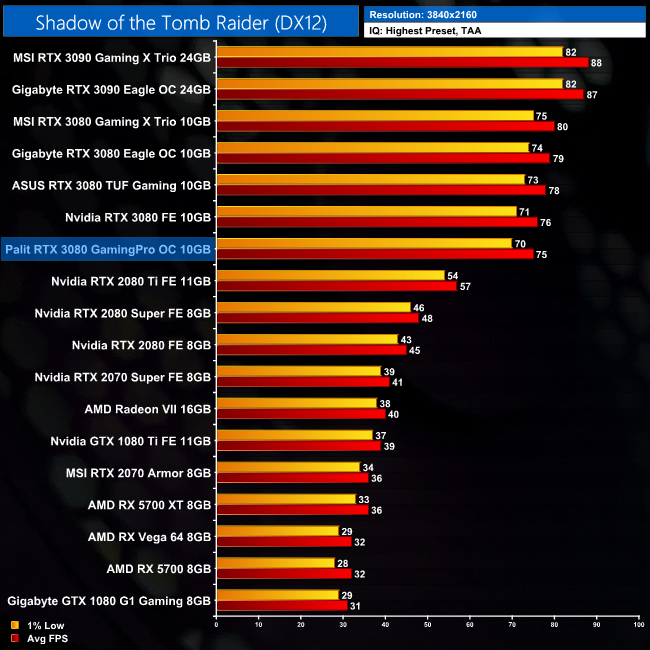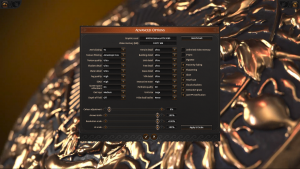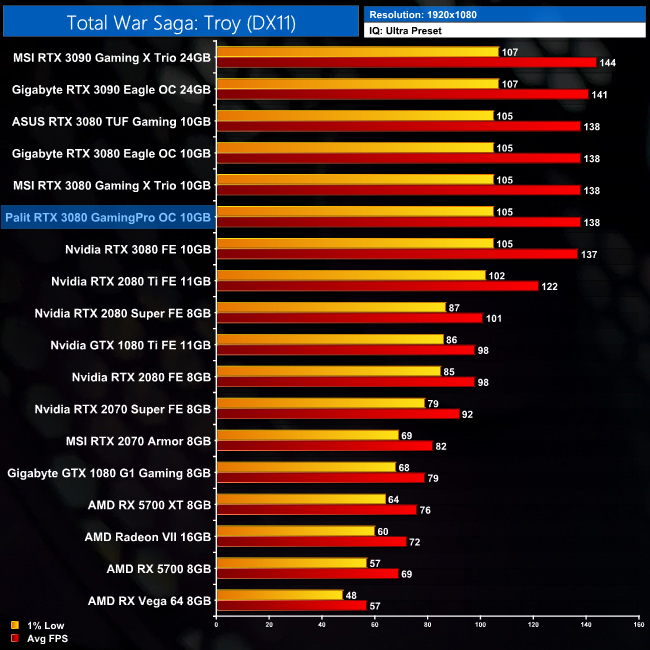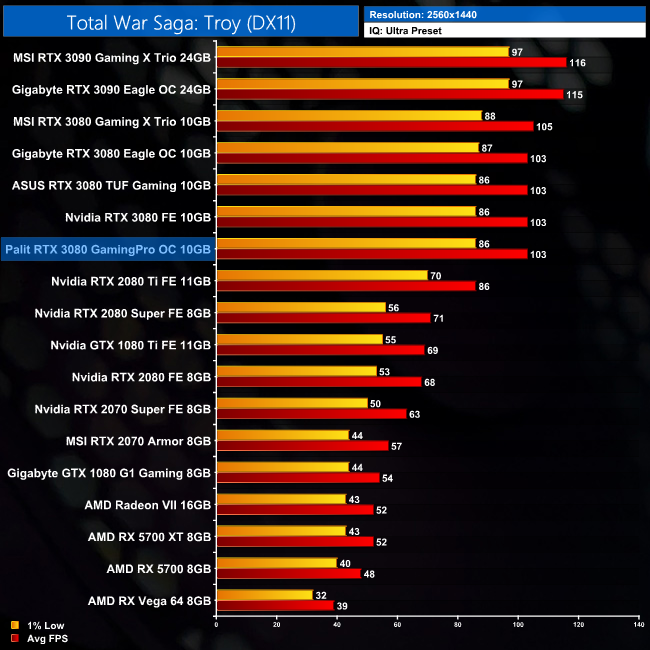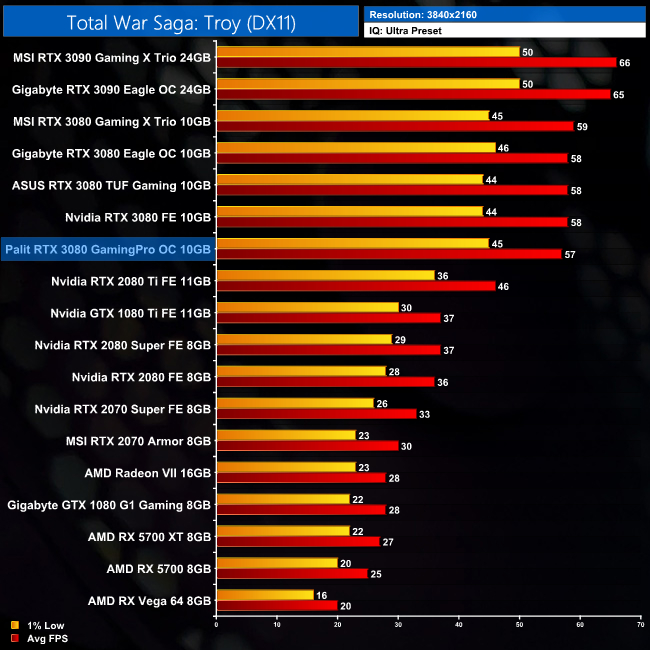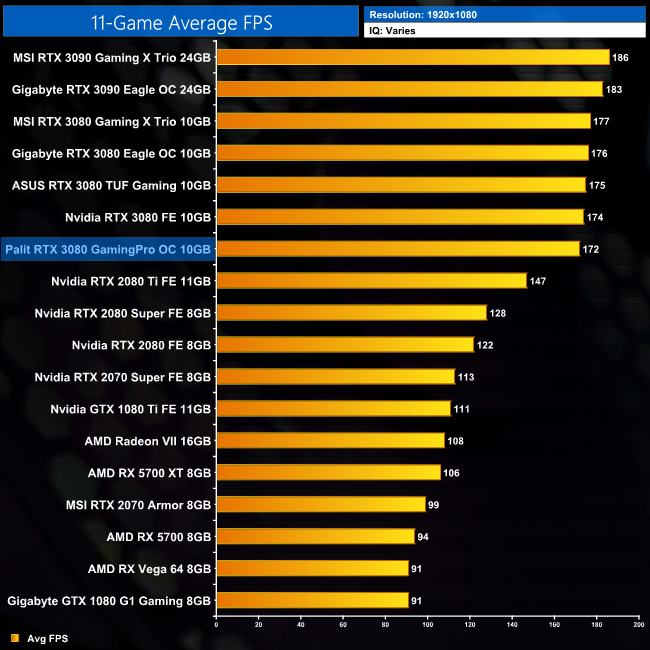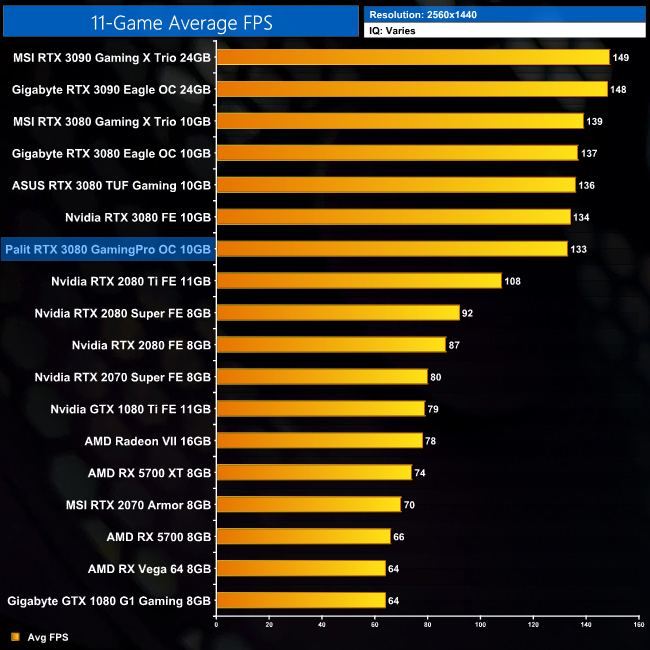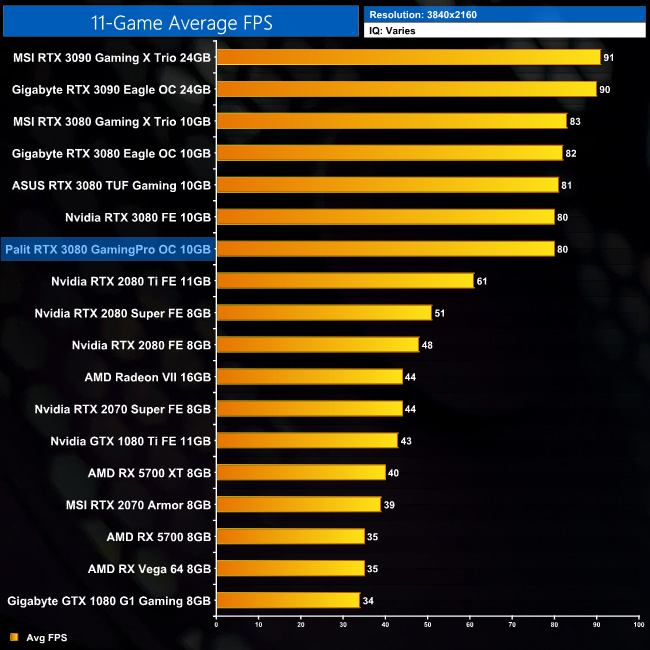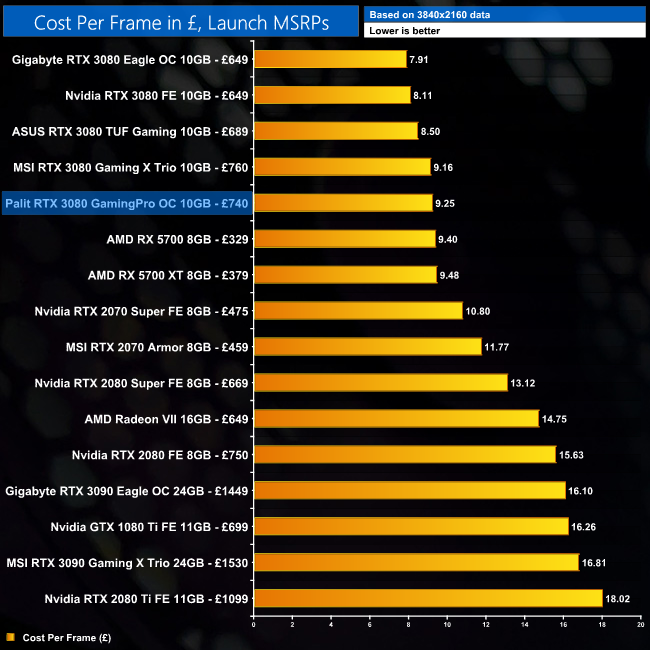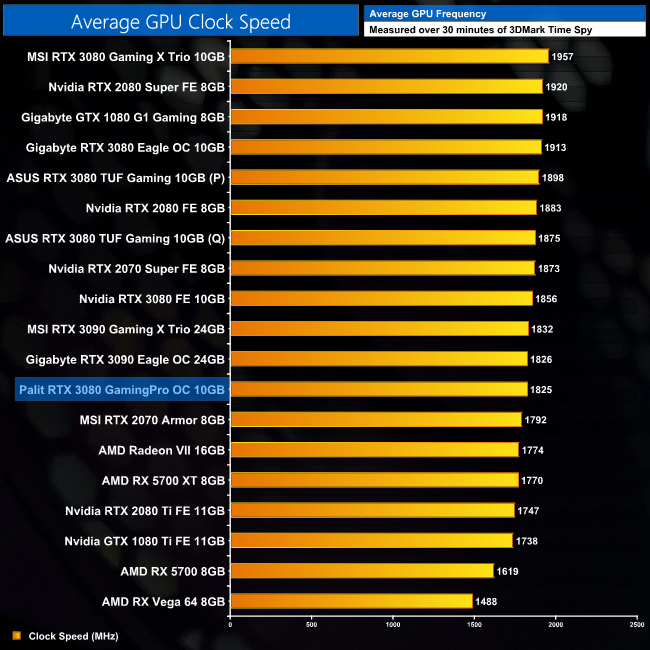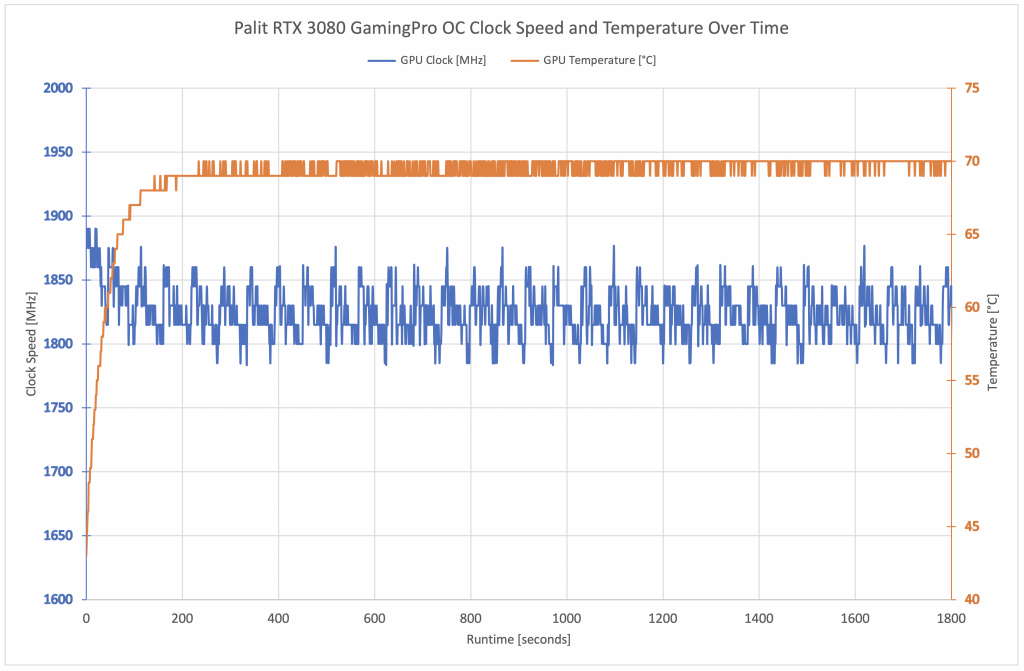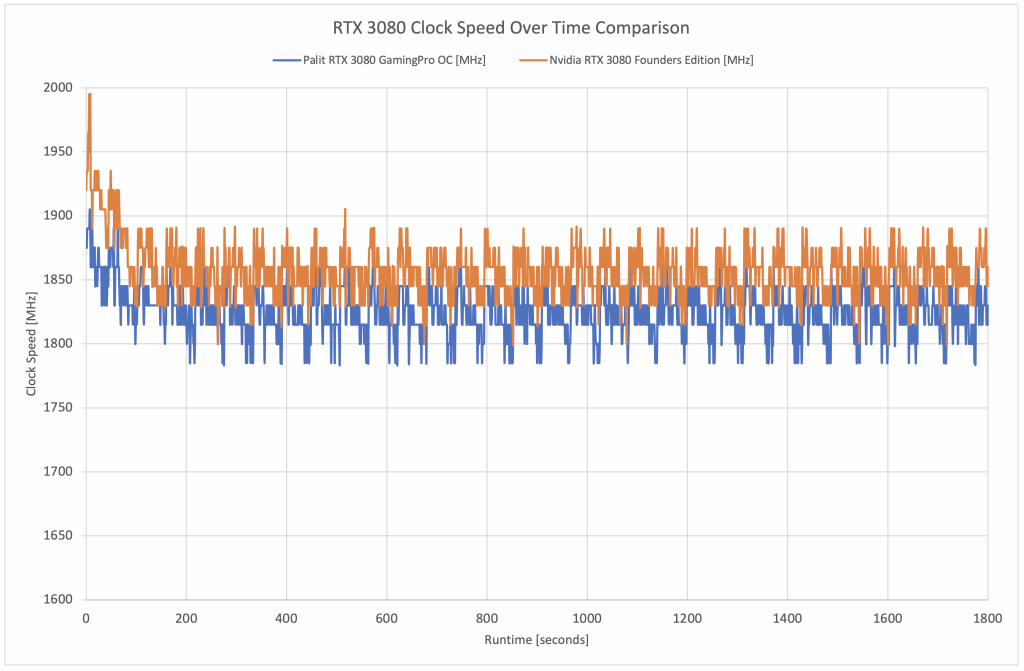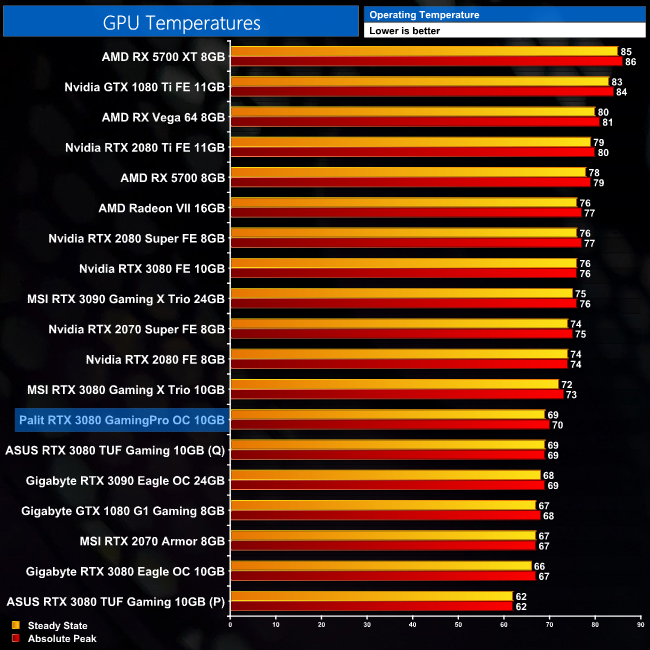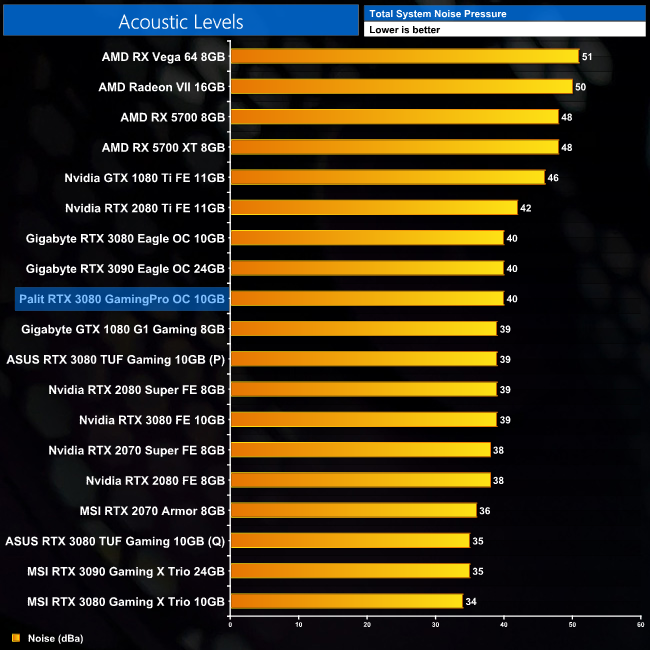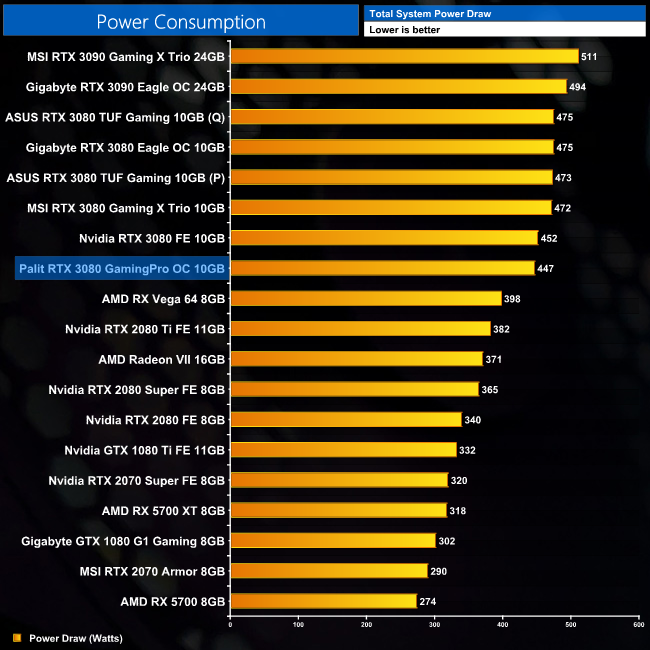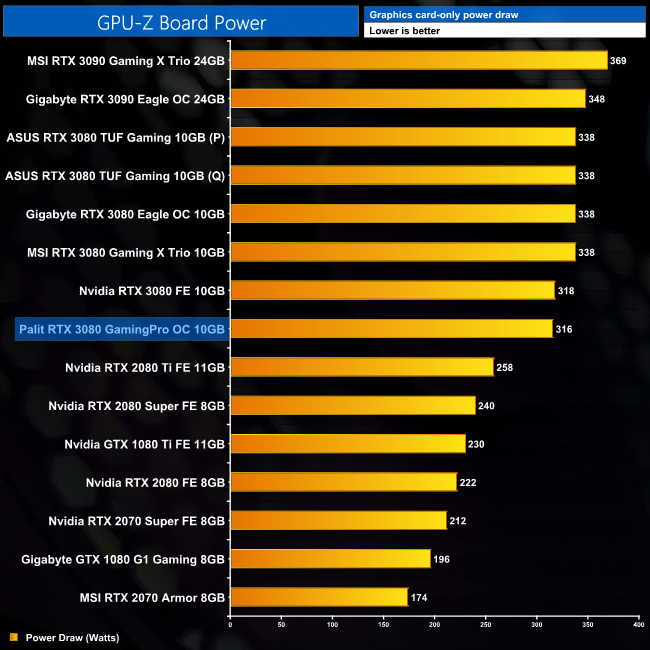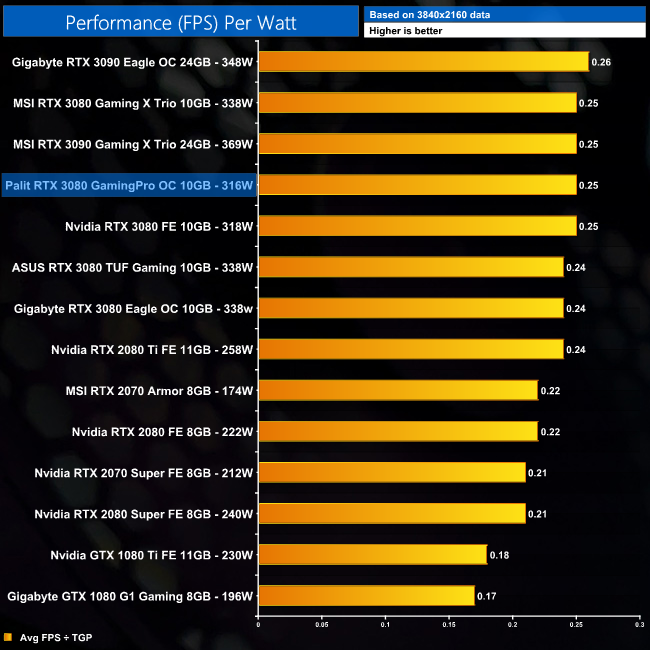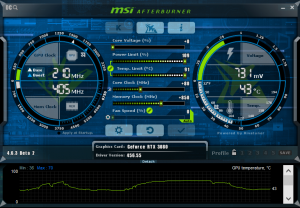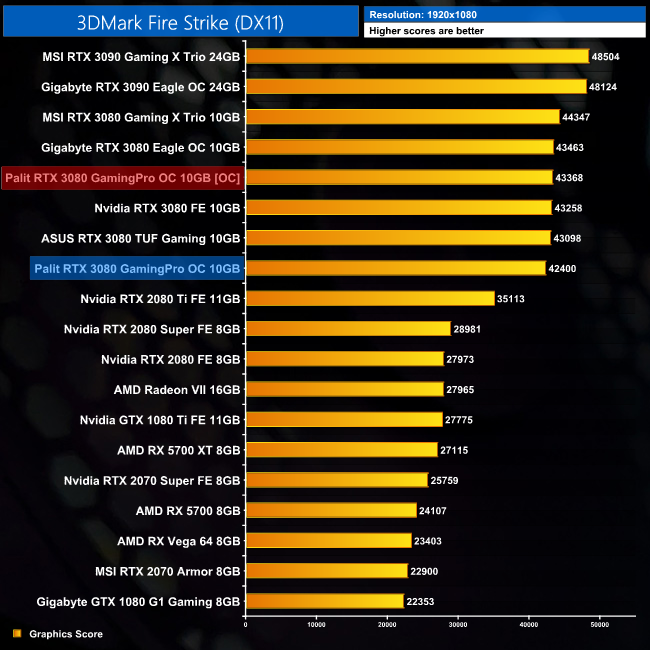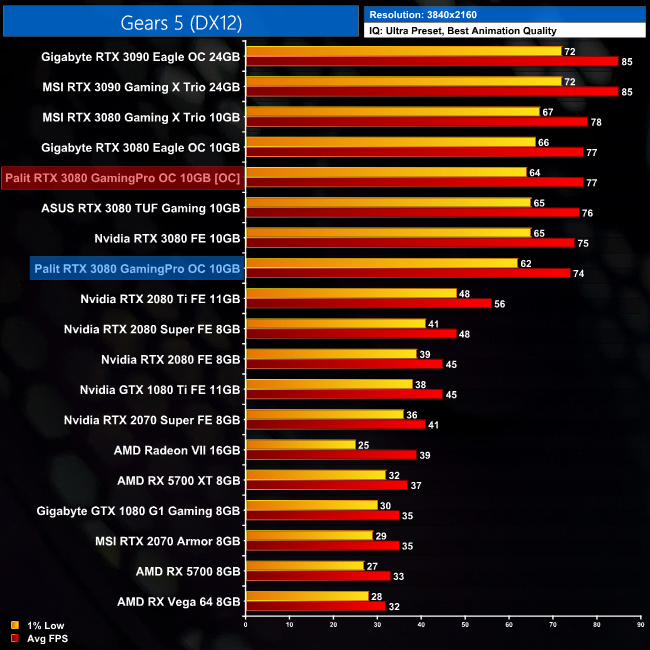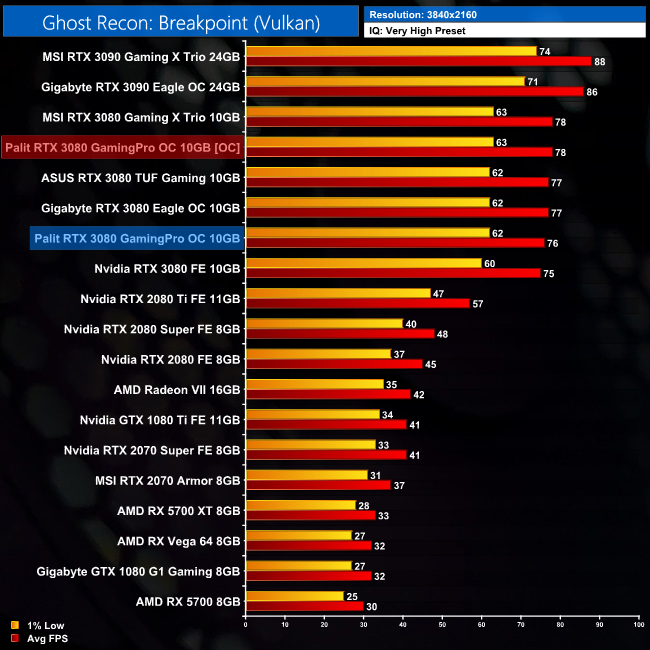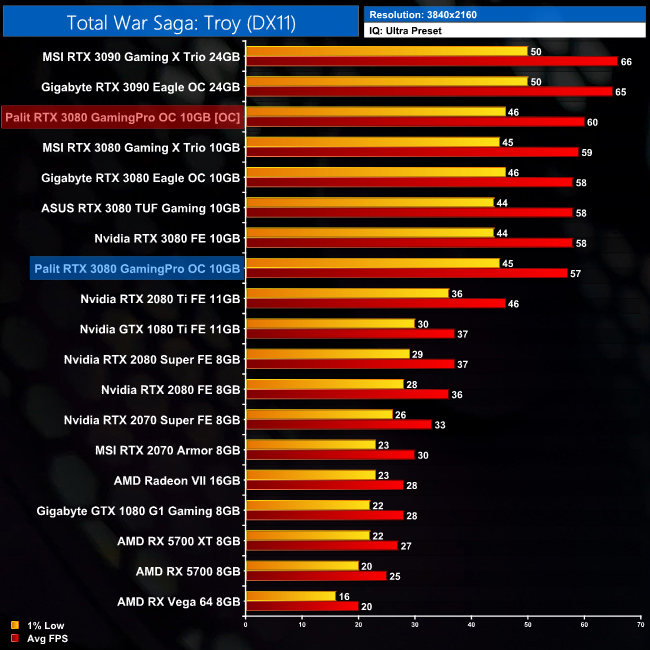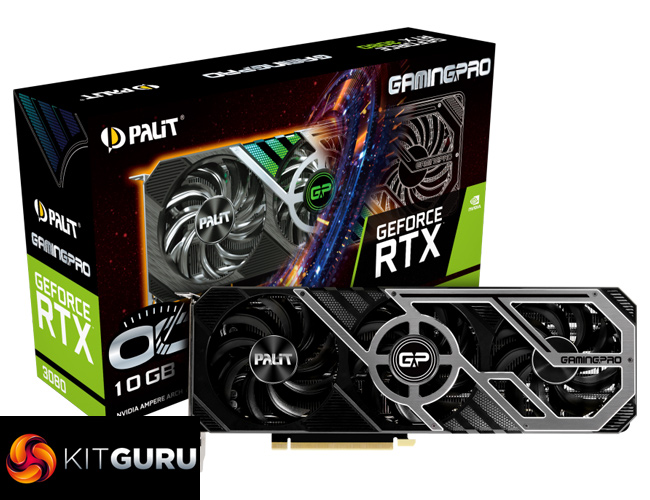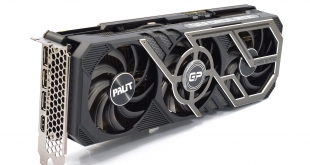
Having already assessed third-party RTX 3080 cards from ASUS, MSI and Gigabyte, today our attention turns to Palit and its RTX 3080 GamingPro OC. This is a triple-fan card, with a factory overclocked core and eye-catching shroud design. With an SRP of £739.99, how does the GamingPro OC stack up against the competition?
So far, we have been highly impressed with all of the RTX 3080 partner cards we have reviewed, so it is now up to Palit to keep that trend going with its RTX 3080 GamingPro OC. Aside from its unique aesthetic, it doesn't look as though this card is bringing anything new to the table, but it is pretty unusual these days to see a graphics card that isn't any taller than the standard PCIe slot, so this could appeal to those with particularly narrow cases.
| GPU | RTX 3090 | RTX 3080 | RTX 2080 Ti (FE) | RTX 2080 SUPER | RTX 2080 (FE) |
| SMs | 82 | 68 | 68 | 48 | 46 |
| CUDA Cores | 10496 | 8704 | 4352 | 3072 | 2944 |
| Tensor Cores | 328 | 272 | 544 | 384 | 368 |
| RT Cores | 82 | 68 | 68 | 48 | 46 |
| Texture Units | 328 | 272 | 272 | 192 | 184 |
| ROPs | 112 | 96 | 88 | 64 | 64 |
| GPU Boost Clock | 1695 MHz | 1710 MHz | 1635 MHz | 1815 MHz | 1800 MHz |
| Memory Data Rate | 19.5 Gbps | 19 Gbps | 14 Gbps | 15.5 Gbps | 14 Gbps |
| Total Video Memory | 24GB GDDR6X | 10GB GDDR6X | 11GB GDDR6 | 8GB GDDR6 | 8GB GDDR6 |
| Memory Interface | 384-bit | 320-bit | 352-bit | 256-bit | 256-bit |
| Memory Bandwidth | 936 GB/Sec | 760 GB/Sec | 616 GB/sec | 496.1 GB/sec | 448 GB/sec |
| TGP | 350W | 320W | 260W | 250W | 225W |
Just before diving into the details, it’s worth reminding ourselves of the key specs for the RTX 3080. Built on Nvidia’s GA102 GPU, fabricated on Samsung’s 8nm process, RTX 3080 houses 8704 CUDA cores, 68 RT Cores and 272 Tensor cores.
A reference board would come clocked at 1710MHz, but as we are reviewing the GamingPro OC edition, this model has a small factory overclocking, with a rated boost clock of 1740MHz. We would still expect GPU Boost to bring actual frequency well above those levels, but we will look at that later in the review.
The 10GB VRAM is provided thanks to Micron’s new GDDR6X memory. Operating at 19Gbps, over a 320-bit bus this gives total memory bandwidth of 760GB/s.
All of those cores, fast memory and factory overclock come at a cost, however, and that is power draw. Reference TGP for a RTX 3080 is 320W, and despite being a factory overclocked card, Palit has stuck with the reference power target with the GamingPro OC.
The Palit RTX 3080 GamingPro OC ships in a black box, with a large image of the graphics card visible on the front.
On the back, there is some multi-lingual product information, highlighting support for DirectX 12 and OpenGL 4.6.
For the included accessories, there's a small user manual, but more interesting is the transparent plastic support bracket. I wouldn't say this is strictly necessary for the GamingPro OC as it is not that big of a card – it's certainly not an MSI Gaming X Trio, put it that way – but it's a nice extra to have included. Above you can see it installed in our Fractal Meshify S2 case, as it proved nearly impossible to photograph with a white background as it is almost completely transparent.
The card itself would look pretty conventional were it not for the metal plate that has been screwed into the plastic shroud. This gives it a pretty eye-catching look, and while it isn't to my taste personally, I can see why it might appeal to some of our audience.
The metal plate sits over two of the three fans, and these measure approximately 85mm in diameter. Using Palit's new TurboFan 3.0 design, these use dual ball bearings and come with IP5X certification. Unlike ASUS and Gigabyte, all three fans spin in the same direction.
In terms of its size, the GamingPro OC certainly isn't small in an objective sense, but is the smallest RTX 3080 partner card we have seen. It measures 294 x 112 x 60 mm, so it is relatively narrow but still fairly long at almost 30cm.
We can also get a look at the unique backplate design. It is a metal backplate that has an almost bronze colour to it, depending on the light. Several honeycomb cutouts are also visible towards the end of the card, designed to allow air to pass directly through the heatsink.
For power requirements, the Palit uses two 8-pin connectors, while we can see the standard array of video outputs – 3x DisplayPort 1.4a, and 1x HDMI 2.1.
Removing the heatsink from the card isn't tricky, but simply doing so resulted in the tearing of all the thermal pads contacting with the memory, which is quite frustrating. I didn't try to prise the pads off, the damage was done just by slowly pulling the heatsink from the PCB. If you buy a GamingPro OC and do want to disassemble the card, perhaps to replace the thermal paste, I'd strongly recommend having a spare set of thermal pads on hand.
That aside, we can see Palit is using what appears to be a reference design, with a 14+2 phase VRM configuration. Memory comes from Micron's D8BGW GDDR6X modules, which run at 19Gbps.
The heatsink itself is covered by a large die-cast aluminium alloy plate. This contacts directly with the memory and VRM. Beneath it, we can see two fin stacks which are connected by a total of 6x 6mm nickel-plated heatpipes.
The metal backplate also contacts with the back of the memory modules via thermal pads.
Driver Notes
- All Nvidia GPUs (except RTX 3000) were benchmarked with the 452.06 driver.
- RTX 3080 was benchmarked with the 456.16 driver supplied to press. For this GamingPro OC model, we used the 456.55 driver.
- RTX 3090 was benchmarked with 456.38 public driver.
- All AMD GPUs were benchmarked with the Adrenalin 20.8.2 driver.
Test System
We test using the a custom built system from PCSpecialist, based on Intel's latest Comet Lake-S platform. You can read more about it over HERE, and configure your own system from PCSpecialist HERE.
| CPU |
Intel Core i9-10900K
Overclocked to 5.1GHz on all cores |
| Motherboard |
ASUS ROG Maximus XII Hero Wi-Fi
|
| Memory |
Corsair Vengeance DDR4 3600MHz (4 X 8GB)
CL 18-22-22-42
|
| Graphics Card |
Varies
|
| System Drive |
500GB Samsung 970 Evo Plus M.2
|
| Games Drive | 2TB Samsung 860 QVO 2.5″ SSD |
| Chassis | Fractal Meshify S2 Blackout Tempered Glass |
| CPU Cooler |
Corsair H115i RGB Platinum Hydro Series
|
| Power Supply |
Corsair 1200W HX Series Modular 80 Plus Platinum
|
| Operating System |
Windows 10 2004
|
Comparison Graphics Cards List
- Gigabyte RTX 3090 Eagle OC 24GB
- MSI RTX 3090 Gaming X Trio 24GB
- ASUS TUF Gaming RTX 3080 OC 10GB
- Gigabyte RTX 3080 Eagle OC 10GB
- MSI RTX 3080 Gaming X Trio 10GB
- Nvidia RTX 3080 FE 10GB
- Nvidia RTX 2080 Ti FE 11GB
- Nvidia RTX 2080 Super FE 8GB
- Nvidia RTX 2080 FE 8GB
- Nvidia RTX 2070 Super FE 8GB
- MSI RTX 2070 Armor 8GB
- Nvidia GTX 1080 Ti FE 11GB
- Gigabyte GTX 1080 G1 Gaming 8GB
- AMD Radeon VII 16GB
- AMD RX 5700 XT 8GB
- AMD RX 5700 8GB
- AMD RX Vega 64 8GB
Software and Games List
- 3DMark Fire Strike & Fire Strike Ultra (DX11 Synthetic)
- 3DMark Time Spy (DX12 Synthetic)
- 3DMark Port Royal (DXR Synthetic)
- Control (DX12)
- Death Stranding (DX12)
- The Division 2 (DX12)
- Far Cry New Dawn (DX11)
- Gears 5 (DX12)
- Ghost Recon: Breakpoint (Vulkan)
- Metro: Exodus (DX12)
- Middle Earth: Shadow of War (DX11)
- Red Dead Redemption 2 (Vulkan)
- Shadow of the Tomb Raider (DX12)
- Total War Saga: Troy (DX11)
We run each benchmark/game three times, and present mean averages in our graphs. We use OCAT to measure average frame rates as well as 1% low values across our three runs.Before we get into our usual testing, we wanted to address the reports of instability that many RTX 3080 users were experiencing. It has been speculated that this instability could be due to to the type of capacitor used on the back of the GPU, with reports suggesting cards with six SP-Caps, or SMD polymer capacitors, were inferior compared to designs that also incorporated sets of multi-layer ceramic capacitors (MLCCs).
During my initial testing process, I tested the RTX 3080 Founders Edition, MSI's Gaming X Trio, Gigabyte's Eagle OC, and the ASUS TUF Gaming OC. I did not experience any instability at all while testing any of those cards, and all of my testing with those models was done before the initial reports of crashing hit the web.
After seeing those reports, I installed this Palit RTX 3080 GamingPro OC in my personal system, and spent a weekend gaming on it, using it like any normal gamer would. During that time, I experienced three crashes to desktop (CTD), over about 5-6 hours of gaming. Like many, I didn't experience any more crashes after underclocking the GPU by -50MHz.
This was all done using the RTX 3080 public launch driver – 456.38. When Nvidia's 456.55 driver appeared, I downloaded that and haven't crashed since when using the GamingPro OC at stock speeds. I used that driver for all of my benchmarks today, and completed all of my testing without a hitch.
Digging into it, it seems the 456.55 driver slightly lowered the GPU's voltage/frequency curve compared to 456.38. Aside from that, Nvidia isn't one to reveal specifics about what has changed, but like I said, I've not experienced any instability from the graphics card when using this driver, so it has certainly done the trick.
Click to enlarge.
In practice, clock speed behaviour is effectively identical between the two drivers – you can see how closely the lines overlap between the data points, as tested over thirty minutes of 3DMark Time Spy. There are a handful of points where the GPU boosted fractionally higher with the 456.38 driver than it did with 456.55, but across the entire 30-minute run, the GPU averaged 1825MHz regardless of the driver used.
So what does that mean for real-world performance? We went back and benchmarked the GamingPro OC using the 456.38 driver, and then again with the 456.55 driver.
What we can see is essentially no difference in real-world performance between the two drivers. The results aren't exactly identical across all of the games, but we're talking margin-of-error differences here. Based on this data, we can only come to the conclusion that performance with the new 456.55 driver hasn't changed, but stability has improved.
Whether or not that means the initial GPU instability was solely due to the drivers, it's hard to say for sure without knowing what else (if anything) Nvidia tweaked with the new driver. It's possible the capacitors could have played a role, resulting in crashes when used in combination with an unfinished driver. At the end of the day though, I certainly think things were blown out of proportion, but with the new driver it is probably time to move on to other things!3DMark Fire Strike is a showcase DirectX 11 benchmark designed for today’s high-performance gaming PCs. It is our [FutureMark’s] most ambitious and technical benchmark ever, featuring real-time graphics rendered with detail and complexity far beyond what is found in other benchmarks and games today.
Kicking off our performance testing with 3DMark, these initial results see the GamingPro OC performing marginally worse than the RTX 3080 Founders Edition, with scores coming in about 2% lower.
3DMark Port Royal is the world’s first dedicated real-time ray tracing benchmark for gamers. You can use Port Royal to test and compare the real-time ray tracing performance of any graphics card that supports Microsoft DirectX Raytracing. As well as benchmarking performance, 3DMark Port Royal provides a realistic and practical example of what to expect from ray tracing in upcoming games.
Port Royal, 3DMark's ray tracing benchmark, sees the GamingPro OC come in just 1% behind the Founders Edition.
Control is an action-adventure video game developed by Remedy Entertainment and published by 505 Games. Control was released on 27 August 2019 for Microsoft Windows, PlayStation 4, and Xbox One. (Wikipedia).
Engine: Northlight Engine. We test using the High preset, with 4x MSAA, DX12 API.
Our first game of the day is Control, and in this title the GamingPro OC is fractionally slower than the RTX 3080 Founders Edition – we're talking a difference of just a single frame at 4K.
Death Stranding is an action game developed by Kojima Productions. It is the first game from director Hideo Kojima and Kojima Productions after their split from Konami in 2015. It was released by Sony Interactive Entertainment for the PlayStation 4 in November 2019 and by 505 Games for Windows in July 2020. (Wikipedia).
Engine: Decima. We test using the Very High preset, with TAA, DX12 API.
Death Stranding sees the RTX 3080 GamingPro OC average 100FPS at 4K, just 1FPS behind the Founders Edition. This puts the Palit GPU 33% ahead of the RTX 2080 Ti.
Tom Clancy's The Division 2 is an online action role-playing video game developed by Massive Entertainment and published by Ubisoft. The sequel to Tom Clancy's The Division (2016), it is set in a near-future Washington, D.C. in the aftermath of a smallpox pandemic, and follows an agent of the Strategic Homeland Division as they try to rebuild the city. (Wikipedia).
Engine: Snowdrop. We test using the Ultra preset, but with V-Sync disabled, DX12 API.
When testing The Division 2, the GamingPro OC fell 2 frames behind the Founders Edition at 4K. This is a difference of 3%, which is the biggest gap – relatively speaking – between the two graphics cards across all of our testing today.
Far Cry New Dawn is an action-adventure first-person shooter developed by Ubisoft Montreal and published by Ubisoft. The game is a spin-off of the Far Cry series and a narrative sequel to Far Cry 5. It was released for Microsoft Windows, PlayStation 4 and Xbox One on February 15, 2019. (Wikipedia).
Engine: Dunia 2. We test using the Ultra preset, with the HD Textures pack, DX11 API.
Far Cry New Dawn once more sees the GamingPro OC sitting just one frame behind the Founders Edition, when testing at 4K. This is an average of 103FPS for the Palit GPU.
Gears 5 is a third-person shooter video game developed by The Coalition and published by Xbox Game Studios for Xbox One, Microsoft Windows and Xbox Series X. It is the fifth installment of the Gears of War series and the sequel to Gears of War 4. The ultimate edition was released on September 6, 2019, while the standard edition of the game was released worldwide on September 10, 2019. (Wikipedia).
Engine: Unreal Engine 4. We test using the Ultra preset, with Best Animation Quality (instead of Auto), DX12 API.
It's more of the same in Gears 5. The Palit GamingPro OC is 1% slower than the Founders Edition at every resolution we tested, but that means it is still 32% faster than the RTX 2080 Ti at 4K.
Tom Clancy's Ghost Recon Breakpoint is an online tactical shooter video game developed by Ubisoft Paris and published by Ubisoft. The game was released worldwide on 4 October 2019, for Microsoft Windows, PlayStation 4 and Xbox One, (Wikipedia).
Engine: AnvilNext 2.0. We test using the Very High preset, with AA disabled, Vulkan API.
Ghost Recon: Breakpoint is the game that bucks the trend, as the GamingPro OC is actually 1% faster than the Founders Edition. Regardless, we are still talking very marginal differences here.
Metro Exodus is a first-person shooter video game developed by 4A Games and published by Deep Silver in 2019. It is the third instalment in the Metro video game series based on Dmitry Glukhovsky's novels, following the events of Metro 2033 and Metro: Last Light. (Wikipedia).
Engine: 4A Engine. We test using the Ultra preset, but with Hairworks and Advanced PhysX turned off, DX12 API.
The Palit RTX 3080 GamingPro OC also edges out the Founders Edition by a single frame in Metro Exodus, when tested at 4K. That puts it 31% ahead of the RTX 2080 Ti.
Middle-earth: Shadow of War is an action role-playing video game developed by Monolith Productions and published by Warner Bros. Interactive Entertainment. It is the sequel to 2014’s Middle-earth: Shadow of Mordor, and was released worldwide for Microsoft Windows, PlayStation 4, and Xbox One on October 10, 2017. (Wikipedia).
Engine: LithTech Firebird. We test using the Very High preset, DX11 API.
In Middle Earth Shadow of War, we once more see the GamingPro OC trailing Nvidia's Founders card by a single frame at 4K.
Red Dead Redemption 2 is a 2018 action-adventure game developed and published by Rockstar Games. The game is the third entry in the Red Dead series and is a prequel to the 2010 game Red Dead Redemption. Red Dead Redemption 2 was released for the PlayStation 4 and Xbox One in October 2018, and for Microsoft Windows and Stadia in November 2019. (Wikipedia).
Engine: Rockstar Advance Game Engine (RAGE). We test by manually selecting High settings, not using a preset, including TAA, Vulkan API.
As for Red Dead Redemption 2, here the GamingPro OC is matching the performance of the Founders Edition, producing 84FPS on average at 4K.
Shadow of the Tomb Raider is an action-adventure video game developed by Eidos Montréal in conjunction with Crystal Dynamics and published by Square Enix. It continues the narrative from the 2013 game Tomb Raider and its sequel Rise of the Tomb Raider, and is the twelfth mainline entry in the Tomb Raider series. The game released worldwide on 14 September 2018 for Microsoft Windows, PlayStation 4 and Xbox One. (Wikipedia).
Engine: Foundation Engine. We test using the Highest preset, with TAA, DX12 API.
Meanwhile, Shadow of the Tomb Raider sees the GamingPro OC fall behind the Founders Edition, but again the difference is just a single frame between the two cards at 4K.
Total War Saga: Troy is a 2020 turn-based strategy video game developed by Creative Assembly Sofia and published by Sega. The game was released for Windows on 13 August 2020 as the second installment in the Total War Saga subseries, succeeding Thrones of Britannia (2018). (Wikipedia).
Engine: TW 3 Engine. We test using the Ultra preset, DX11 API.
Our final game of the day is Total War Saga: Troy, and this is pretty typical of our testing today – the GamingPro OC is just a single frame slower than the RTX 3080 Founders Edition at 4K.
Here we present frame rate figures for each graphics card, averaged across all 11 games on test today. These figures can disguise significant variations in performance from game to game, but provide a useful overview of the sort of performance you can expect at each resolution tested.
Using the average frame rate data presented on the previous page, here we look at the cost per frame using the UK MSRP launch prices for each GPU.
Calculating the cost per frame, using the £739.99 SSRP given to use by Palit, shows this to be the overall worst value RTX 3080 that we have tested so far. Of course, that is based on manufacturer-provided pricing, and the other partner cards listed in the chart are simply not available at those prices at the time of writing. Even then, this RTX 3080 is still better value than anything out there for 4K gaming right now.
Here we present the average clock speed for each graphics card while running the 3DMark Time Spy stress test for 30 minutes. We use GPU-Z to record the GPU core frequency during the Time Spy runs. We calculate the average core frequency during the 30 minute run to present here.
Click to enlarge.
Throughout our game benchmarks, we saw the Palit GamingPro OC perform very slightly worse than the Nvidia Founders Edition in terms of in-game frame rate. This is explained by the fact that the GamingPro OC GPU was simply running slower in terms of its clock speed.
Despite having a rated boost clock of 1740MHz, which is 30MHz above stock clocks, in the real world the card averaged 1825MHz, which is about 30MHz slower than the Founders Edition. We can see in our second scatter graph, where we compare the clock speed behaviour over 30 minutes for both the Palit and Nvidia Founders Edition, that the Nvidia card is consistently running at higher speeds.
This isn't a case of the Palit card thermal throttling, too, as it remained above its rated boost clock at all times. It simply wouldn't boost as high as the Founders Edition, and the potential explanations for this are numerous – Nvidia has a 15-phase VRM for the GPU, compared to Palit's 14-phase VRM, while it could be that our particular sample hasn't performed well in the ‘silicon lottery'.
For our temperature testing, we measure the peak GPU core temperature under load. A reading under load comes from running the 3DMark Time Spy stress test for 30 minutes.
Thermally, the GamingPro OC does well. We saw a peak temperature of 70C across our thirty minute stress test, putting the GamingPro OC right in the mix with the ASUS TUF Gaming and Gigabyte Eagle OC models. It doesn't run quite as cool as those cards, but it is very close, and either way a peak temperature of 70C is very respectable. That's also 3C cooler than the MSI RTX 3080 Gaming X Trio.
We take our noise measurements with the sound meter positioned 1 foot from the graphics card. I measured the noise floor to be 32 dBA, thus anything above this level can be attributed to the graphics cards. The power supply is passive for the entire power output range we tested all graphics cards in, while all CPU and system fans were disabled. A reading under load comes from running the 3DMark Time Spy stress test for 30 minutes.
In terms of noise, we saw 40dBa on our sound meter when testing the GamingPro OC. This is still very easy on the ears, and puts it on level pegging with the Gigabyte Eagle. Technically, it is louder than the Founders Edition and ASUS TUF Gaming (using the performance BIOS) which both recorded noise levels at 39dBa, but to the human ear I couldn't say the difference would be perceptible.
For those interested, this noise reading came with the fans spinning at 48%, or around 1890rpm.
We measure system-wide power draw from the wall while running the 3DMark Time Spy stress test for 30 minutes.
System wide power draw is fractionally lower than the RTX 3080 Founders Edition, that is perhaps a little surprising but there isn't a lot in it.
We also use GPU-Z to measure Board Power (graphics card-only power draw). This is currently only available for Nvidia cards, which is why we have excluded AMD results from the chart. Aside from the fact this is software-based reporting, and not a hardware measurement of the PCIe power cables and PCIe slot (for that we’d need something like PCAT), this should provide us more accurate data to work with as it is measuring only the GPU power, and not total system power which is a fundamentally imprecise measurement.
Despite both the GamingPro OC and the Founders having a 320W power target, the GamingPro OC came in just shy of that, averaging 316W based on the GPU-Z Board Power metric.
By using the GPU-Z Board Power data in conjunction with the 11-game average FPS data we presented earlier in this review, we can work out performance per Watt for each graphics card. This is presented as FPS per Watt.
With power draw and performance pretty much equal between the GamingPro OC and the Founders Edition, it's no surprise to see performance per Watt is also a tie between the two. This means the GamingPro OC does deliver fractionally better performance efficiency compared to the TUF Gaming or Gigabyte Eagle OC, but we're talking the smallest of margins here.
By now we know that overclocking Ampere is pretty much an exercise in futility, as we have seen precious little gains when overclocking our other review samples. Still, we tried again with the GamingPro OC, and managed an extra 80MHz to the GPU core, and 850MHz to the memory, bringing speeds to 20.7Gbps (a 9% increase.)
As expected, the real world performance gains were not big. At worst, we saw just a 3% improvement to frame rate in Ghost Recon: Breakpoint, and at best the extra frequency netted us improved frame rates of 5% in Total War Saga: Troy.
Palit's RTX 3080 GamingPro OC is the fifth RTX 3080 to come through our doors, as we have already looked at the RTX 3080 Founders Edition, MSI's Gaming X Trio, Gigabyte's Eagle OC, and the ASUS TUF Gaming OC. That means the Palit really had its work cut out to impress me, as some of those other partner cards performed incredibly well during our testing.
Starting first with gaming performance, the GamingPro OC is actually the slowest RTX 3080 we have tested so far, proving 1% slower on average when compared to Nvidia's Founders Edition, while that margin increases to 5% when compared to the MSI Gaming X Trio. In all honesty though, I don't think this matters at all. We're talking margins of just one or two FPS at 4K, so in the real world you just wouldn't be able to tell the difference. There's no getting around it, the GamingPro OC is objectively slower, but I don't think that should be the basis used as to whether or not you buy this card.
On the subject of performance, at the beginning of this review we looked at the instability issues many RTX 3080 users have been reporting, and this is something we experienced with the GamingPro OC. Do check back to page 4 of this review if you want the full analysis, but suffice to say Nvidia's 456.55 driver fixed the issue for me (and appears to have done the same for many others), without any difference to performance, so until I see evidence to the contrary, I would consider that matter closed.
Elsewhere, Palit's cooler design has proved to be pretty competitive. For starters, it runs cool, hitting a peak temperature of 70C during our testing. This is 3C cooler than the MSI Gaming X Trio, and 6C cooler than the Founders Edition, though Gigabyte's Eagle OC and the ASUS TUF Gaming do better in this regard.
Similarly, for noise levels, the GamingPro OC is on par with the Eagle OC, and only very marginally louder than the Founders Edition. The TUF Gaming, when using its Quiet BIOS, is noticeably quieter however, but the GamingPro OC could not be described as a loud card and it did not bother me in the slightest during my testing.
One slight annoyance I had with the overall card design was in terms of the disassembly, where we saw the thermal pads used for the memory completely torn in two – just by removing the heatsink from the PCB. I can't say this would happen with all of the GamingPro OC models out there, but if you would plan on disassembling the card for whatever reason, I would advise having some backup thermal pads on hand should you need them.
All told, the Palit RTX 3080 GamingPro OC is a solid card, no doubt about it. Objectively speaking, it doesn't do much wrong. The only reason we are not being overly effusive about it is because it is up against some very stiff competition. The ASUS TUF Gaming RTX 3080 OC, for instance, is measurably better in terms of its thermals, noise levels and operating frequency, while that card also has the benefit of its dual-BIOS functionality and all-aluminium shroud.
That's not to say you shouldn't buy the Palit, but I think a lot of it will depend how the pricing and availability situation unfolds. Palit told us the SRP for the GamingPro OC is £739.99, which would be about £50 more than the ASUS TUF Gaming, if cards were actually available at that price point. Considering demand is expected to outstrip supply for at least the rest of the year, it's very hard to say how real-world pricing of these cards will pan out. Objectively speaking, there are better performing RTX 3080s out there, but if you can find the GamingPro OC at a good price in the coming months, it will still do the job very nicely.
Right now, the GamingPro OC is listed for pre-order on Overclockers UK, priced at £749.99 HERE.
Discuss on our Facebook page HERE.
Pros
- RTX 3080 performance is highly impressive for 1440p and 4K gaming.
- GPU hit a peak temperature of just 70C.
- Easy on the ears (even if it is marginally louder than the Founders Edition.)
Cons
- Up against some very stiff competition from the likes of ASUS and Gigabyte.
- Limited overclocking headroom.
KitGuru says: It may not have blown our socks off, but this is still a very capable graphics card. Let's hope we will see it come into stock soon.
 KitGuru KitGuru.net – Tech News | Hardware News | Hardware Reviews | IOS | Mobile | Gaming | Graphics Cards
KitGuru KitGuru.net – Tech News | Hardware News | Hardware Reviews | IOS | Mobile | Gaming | Graphics Cards


